Best Kitchen Paint Colors (Ultimate Design Guide)
In this gallery, we explore the best kitchen paint colors for a variety of cabinetry and design styles.
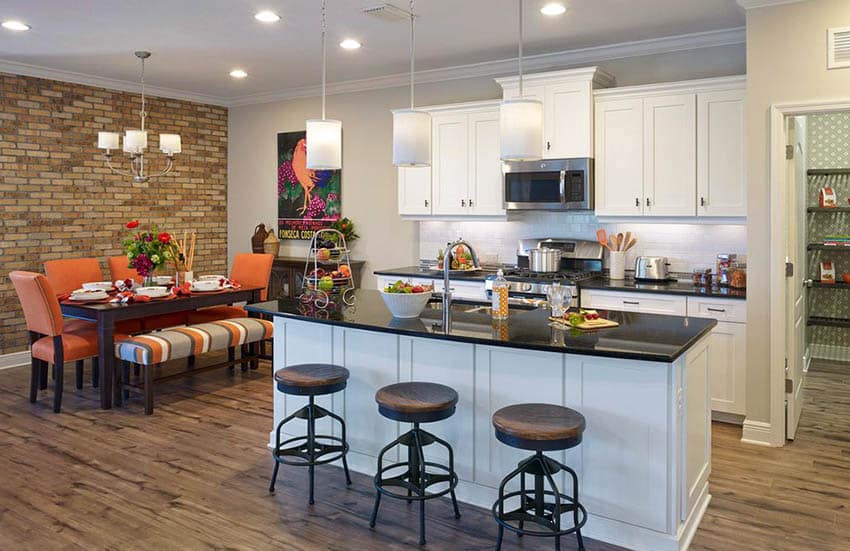
Experts agree that it’s not just the paint colors of the walls that help determine the overall look and feel of a space. In a kitchen, your wall color must also relate to the colors of your cabinetry, the countertops, the backsplash materials, floor finishes, appliances, and accessories.
With all the visual elements to consider and all the endless paint choices to choose from, choosing the perfect paint for your kitchen can be quite baffling. Before you rush out to buy that gallon of paint, it is important to know what colors work best with specific kitchen cabinet colors and finishes. Below, we give you our very own complete guide on the best kitchen paint colors to help you eliminate the guesswork in formulating an effective color scheme.
Paint Ideas for the Kitchen
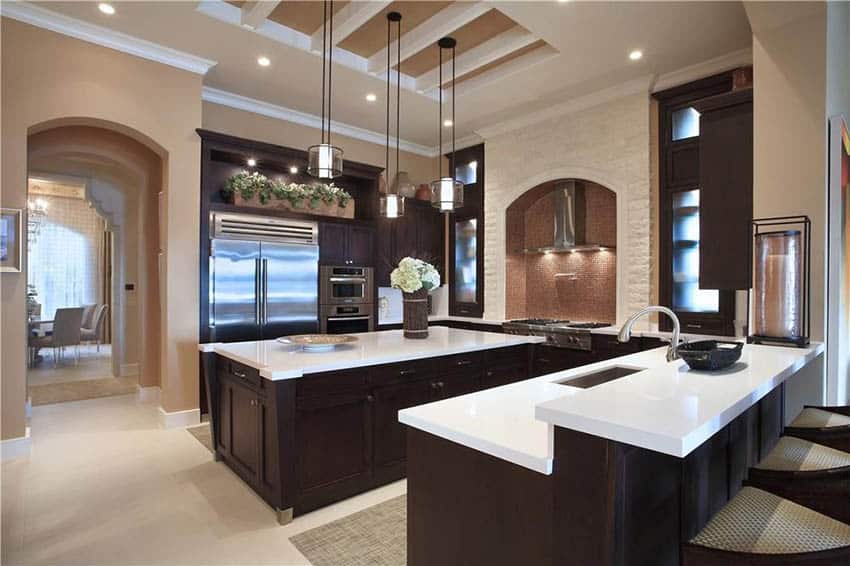
Kitchen paint colors can be selected according to one’s personal taste, preference in style, and the look that one wants to achieve for one’s home. Here are some tips and kitchen paint ideas that can help you pick out the best paint colors for your kitchen:
Envision the general “feel” and overall look you want to achieve for your kitchen. Ideally, the look of a kitchen must jive with the prevailing style of your home. However, there is no limit in design, and you can be eclectic if that suits your taste. Before applying that paint color to your kitchen walls, take some time to assess the room and determine the look and feel you want to imbibe.
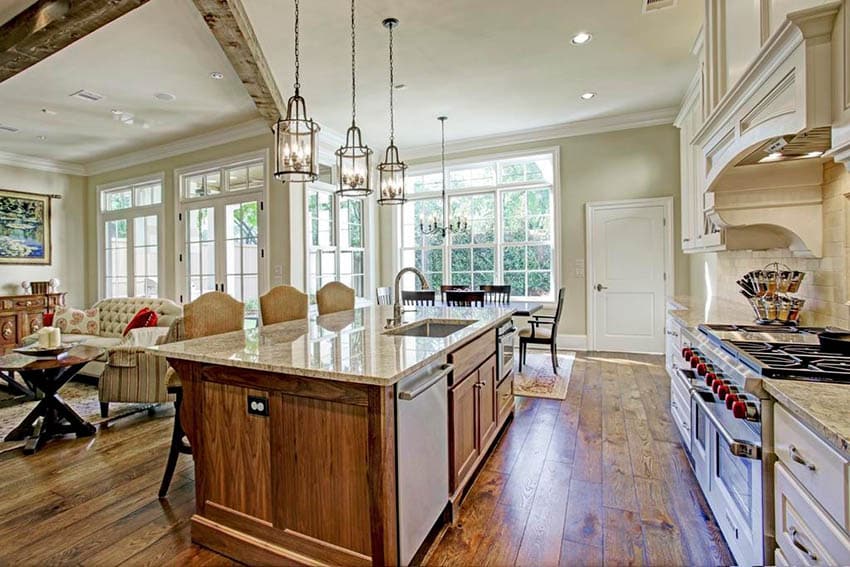
Consider all the other visual elements in your kitchen. Before you get started with choosing the right paint color for your kitchen, there are a few items that you need to take into consideration. Other visual elements in the space, such as accessories, furniture, furnishings, and finishes, can help you narrow down your kitchen paint choices and choose the best, which will help you create a well-balanced color scheme. Think about the dominant features in the kitchen, such as the countertops, flooring material, kitchen cabinets, backsplash, and fixtures that you plan on installing or already have.
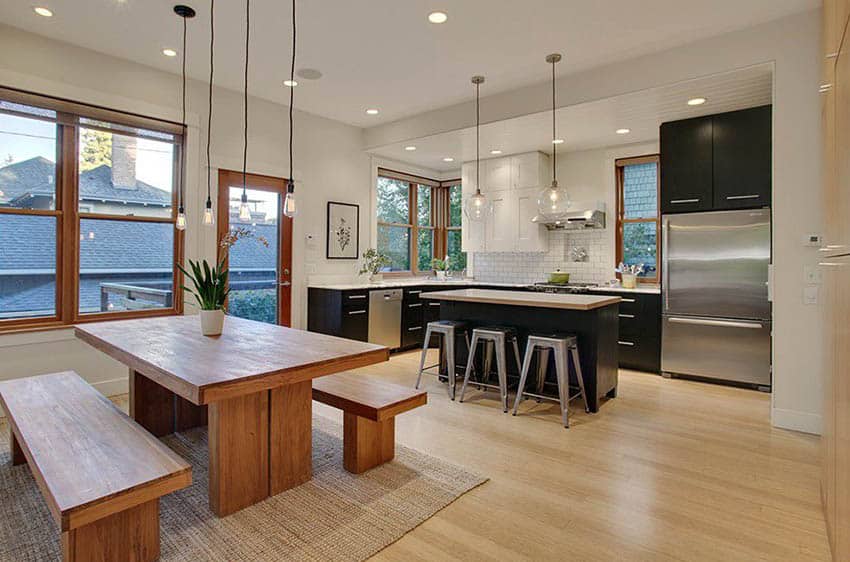
Alternatively, if you are planning on completely changing the whole look of your kitchen and are deciding on buying new furniture and accessories, then you can use your kitchen paint color to anchor the space, and it can serve as a foundation for all the other items that you will be needing. If you take into consideration all of the elements in the space, you are more likely to come up with a color scheme that makes sense for your kitchen.
Purchase semi-gloss or satin finish for your kitchen walls. Kitchens are high-traffic areas, and they are constantly used on a day-to-day basis. It is highly exposed to moisture, dirt and grime, oil splatters, grease, and food residues. With that in mind, maintenance and performance must also be a high priority when choosing the right paint for your kitchen. The flat paint finish does not work well for kitchens because it has the tendency to get dirty more easily. Semi-glossy surfaces, which are smoother, can be wiped down more easily and are less maintenance-intensive than flat-finished walls.
Use oil-based paint for your kitchen cabinets. If painting your kitchen cabinets, consider using an oil-based paint to ensure the paint does not peel off or chip over time. Kitchens are constantly exposed to high temperatures and moisture, and other types of paint can easily get damaged from such.

Always do your prep work before painting your kitchen. Before painting your kitchen, make sure to remove any type of appliance, such as the fridge or stove, or small appliances like blenders, microwaves, etc. Remove any type of hardware and keep them in a safe place if you plan on using them again.
Before applying paint to your walls, make sure to clean them. Wipe down your walls using a cloth to remove any type of oil, grease, and dirt. Most of the time, even if your kitchen’s walls have already been cleaned, there’s some chance that they still have some grease and moisture on them, and putting on a coat of primer before applying the first coat of paint will make sure that the paint glides on smoothly to the surface. Use painter’s tape to outline the edges where the kitchen cabinets and walls meet, and to avoid any stain in your floor, make sure to cover it with drop cloths, plastic, or newspaper.
Always sample your paint your paint choices before deciding on the final color you want for your kitchen walls. Perhaps you may have fallen in love with that charming lavender wall paint you’ve seen in an interior design magazine or have been feeling all excited with the hundreds of paint swatches that you’ve seen in a local home improvement store, but keep in mind that the color of the paint may vary once applied to an actual wall or a bigger surface. A certain shade of paint may look lighter or darker depending on the lighting conditions of the space.
Sampling the shade that you prefer is the best way to know whether you want to stick with it or change it. Most suppliers offer paint in small quantities, which can be used for sampling. If you are deciding on three shades, apply all of your samples to one wall so you can compare which one works best. You can also use your wall samples to compare with swatches of your flooring, kitchen cabinet finish, and countertop to see if they match. Sampling also provides you with an overall feel of the paint color in your kitchen.
Keep in mind the resale value of your home. If you are planning to resell your home in the future, it is important to choose a kitchen paint color that will not go out of style. While you may be really attracted to a bold shade, some potential buyers may find it too intense or less appealing. Your kitchen paint color must be refreshing and must not make potential buyers feel dragged. Opt for muted hues, toned-down colors, and neutrals, as these colors are proven to be more timeless and can go well with almost anything.
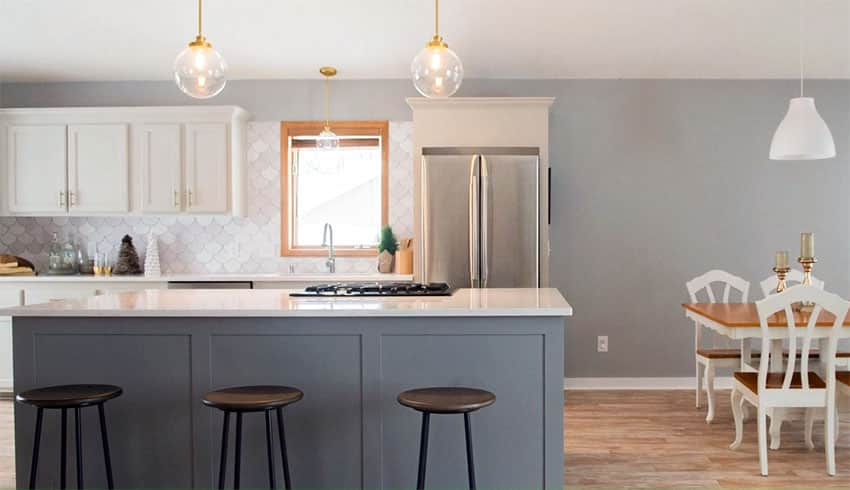
Blending, on the other hand, is the opposite: light walls with light-colored cabinets and countertops. Contrast helps create a striking and bold statement while blending creates a more minimalist and uniform appearance. Once you have decided on whether you want to blend or contrast, you can now apply the color variations to the dominant elements of your kitchen, such as wall paints, kitchen cabinet colors, countertops, and flooring.
Do not forget to personalize. The beauty of interior design is that it allows you to freely create a space that will cater to your personal needs and will suit your personal taste and style. You can choose your favorite color to paint a wall in your kitchen to make a mark of your personality in the space, then complement it with other design elements.
Best Colors to Paint for Small Kitchens
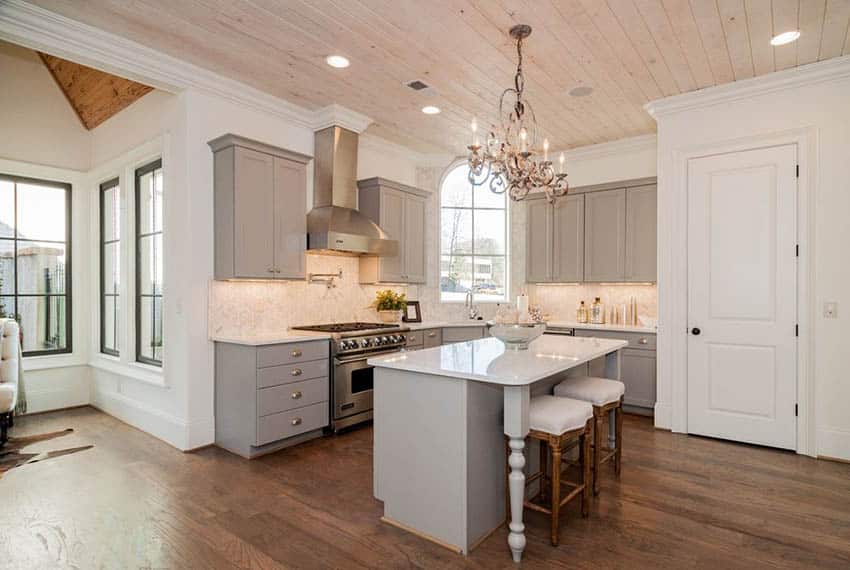
White-painted walls are one of the best options you can explore for a small kitchen. In addition to all of the mentioned benefits above, white calls can simply add a touch of class and timelessness to a space. It will never go out of style and is versatile enough to work its way into different types of kitchen styles whether it may be traditional or modern.
Aside from that, there are hundreds of paint choices for the color white alone, and it comes in multiple shades and tints. Some are geared toward a very ultra-white color, while others belong to the warmer side of the spectrum with their warm undertones. The key to choosing the right white paint for a small kitchen is to understand the prevailing style of the space. Traditional and transitional-inspired kitchen settings tend to go with warmer shades of white, while contemporary and modern-inspired kitchen settings call for brighter and “whiter” counterparts.
There are many ways to explore white paint for small kitchens. You can either go with an all-white color palette to maximize the space to its fullest potential or introduce pops of colors to prevent the space from looking too bland. Layering different versions of white and complementing them with a variation in the finishes and textures can help create depth in a small kitchen space while also providing a heightened level of visual interest.
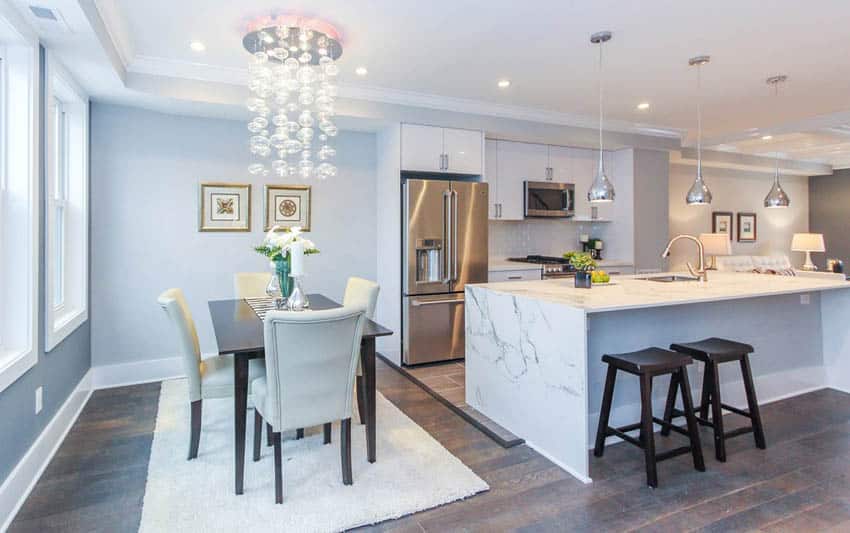
Some popular pastel colors that work best as paint colors for small kitchens include mint greens, pale yellows, and powder blues. Despite the limited size, you can still turn a small kitchen into any type of setting while also making it feel bigger. Cerulean and powder blue paint can be used to transform a small kitchen into a coastal haven. Mint green paints can be used to give small kitchens a vintage appeal, while soft, mellow yellows can be used to evoke cottage charm in a small kitchen.
In addition to choosing white and light colors as paint for small kitchens, it is also ideal to enhance the space with good lighting. Lighting plays an important role in the way color is perceived. Good lighting is also an essential part of creating the right mood and ambiance for a small kitchen. Keeping your small kitchen adequately lighted can double the effect of light and white-colored walls in making the space look brighter, more airy, and bigger.
Best Shades for Kitchen Walls

They say that colors are integral not only in interior design in terms of aesthetics but also in creating an atmosphere, and a good way to narrow down hundreds of paint and color choices is to understand a few basics on how colors tend to affect people’s mood and perception towards it. There are certain colors that work best for bedrooms, living rooms, or, in this case, kitchens. The bedroom, for example, being a place for rest and relaxation, would require a calm and refreshing color palette, and a good way to produce such is by using cool hues of blue and green. In the same way, the kitchen, being the heart of the home, needs to promote an inviting atmosphere.
Some of the most popular paint colors for kitchens include neutrals like white and gray, warm hues like red and yellow, and cool hues like blue and green. You can help match colors by downloading a paint color app found on this page.
Below we discuss how each of these colors can be used to brighten up the most important area of your home.
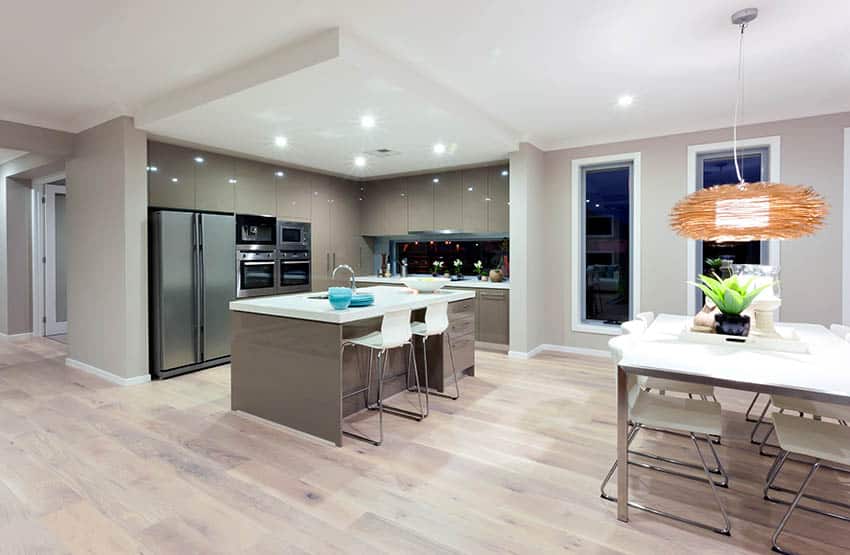
Neutrals have always been a staple as a wall color for most homes. While these colors are often perceived to be too safe, dull, and boring, they can indeed stand out when used with the right layering of finishes, textures, and accents.
Neutral colors include shades of white, black, gray, and brown. While its variations include beige, ivory, taupe, or those that “appear to be without color”. Neutrals typically have undertones, and with enough tint or shade, any color can become neutral. It can be adjusted into different tints and shades, depending on what you want. With the addition of red, yellow, and orange undertones, a neutral can be warmed up, and alternatively, it can also be cooled down with the addition of blue, green, and purple undertones. A safe choice for kitchen wall color is to use a mid-range neutral.
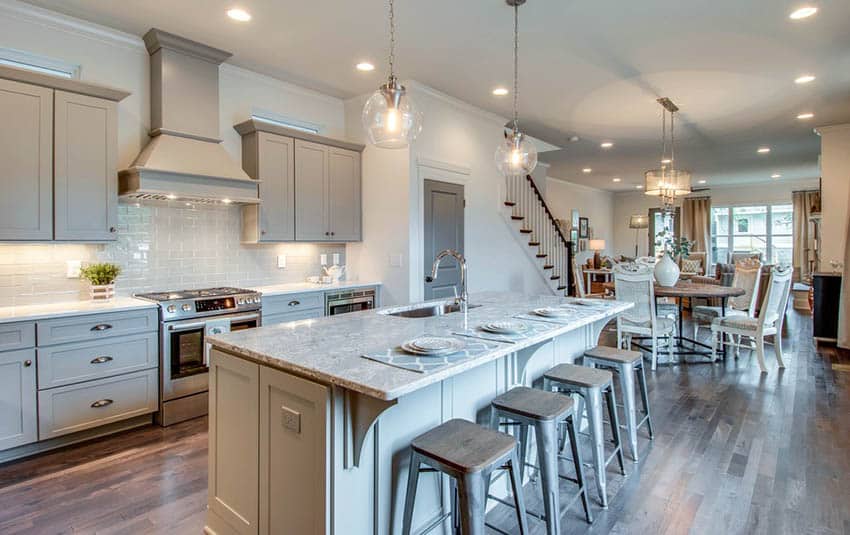
A white kitchen wall will not limit you from exploring cabinet colors, countertops, or flooring materials. You can go with an all-white color palette and enjoy a calming atmosphere for your kitchen or you can combine white walls with pops of colors to create a more lively environment. The possibilities are actually endless. In addition to the remarkable versatility of white kitchen walls, it is also proven to be a timeless choice and can go with any type of kitchen setting, whether it may be traditional, transitional, country, contemporary or modern.
As most people start their days in the kitchen, a white wall can instantly make this room feel more energized. The color white promotes health hygiene and gives the kitchen a fresh and clean look. Its crisp color can instantly make a kitchen feel more airy and inviting. And since it is a light color, it can bounce off natural lighting more easily, thus creating a brighter space. White and light-colored walls are also highly suited for small kitchens because they can create an illusion of space, making the room feel larger.
White-on-white color palettes are also a constant in the kitchen design scene. The reason for this is that going with an “all-white” scheme can instantly balance your kitchen and make it more calming, especially since it is considered to be one of the busiest areas of the home. Walking in an all-white kitchen can make you feel relaxed, but at the same time, it can wake you up. An all-white look for the kitchen can be pulled out by using white walls with white cabinets, white countertops, and a white ceiling. With the right texture, this look can be super stylish and stunning.
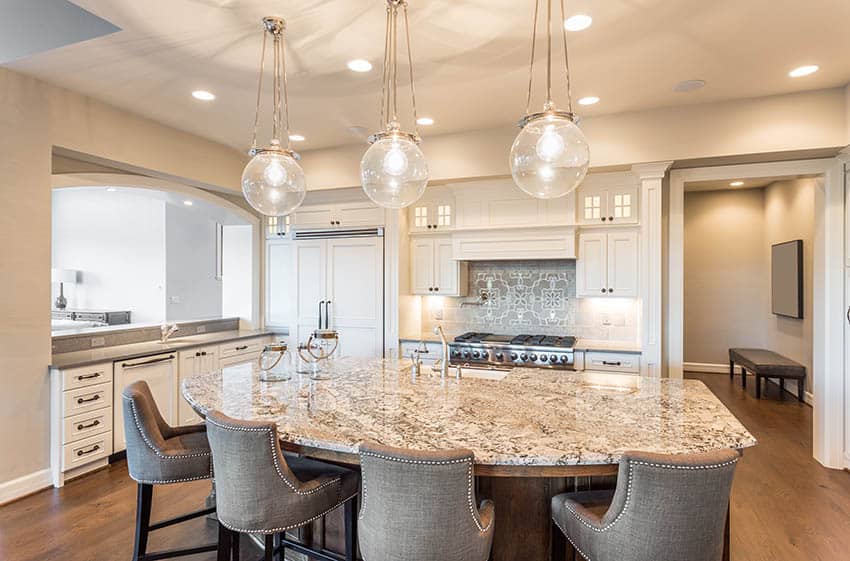
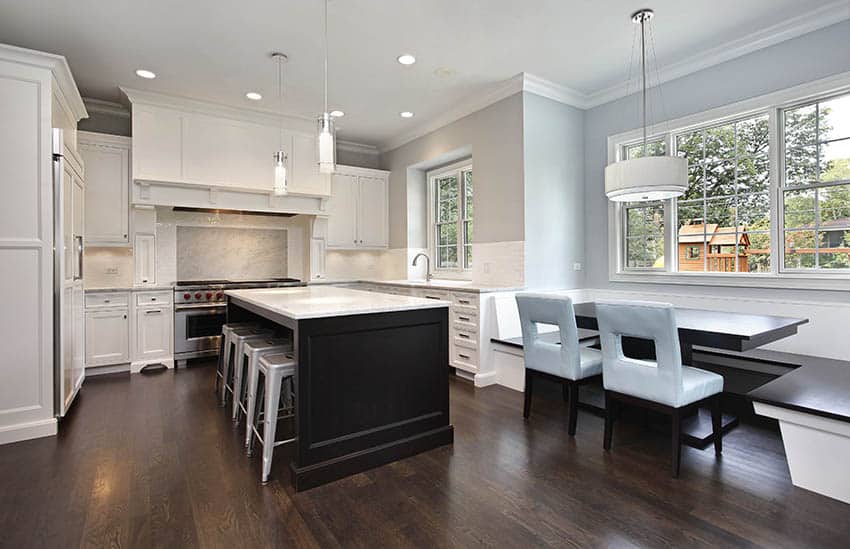
Gray walls can work wonders in a kitchen setting. Since it is neutral, it offers versatility and flexibility in terms of mixing and matching other elements in the space. Gray walls can pair beautifully with lighter neutrals like white or beige to create a serene kitchen setting, or it can also be complemented with vibrant splashes of color like mustard yellow or pumpkin orange to produce a more modern vibe. Not only does it work as a wall color, but gray can also be used as a countertop and cabinet color for kitchens. In general, gray walls can be used for any type of kitchen setting, whether it be traditional or modern. Overall, gray walls exude sophistication and stylishness.

Best cool hues for kitchen walls
Tints and shades that belong to the color family of blue, violet, and green are classified as cool hues and are best known for their calming effect and the refreshing feel that they contribute to spaces. Among these colors, blue and green can be used to create a bright and inviting kitchen setting for your home.
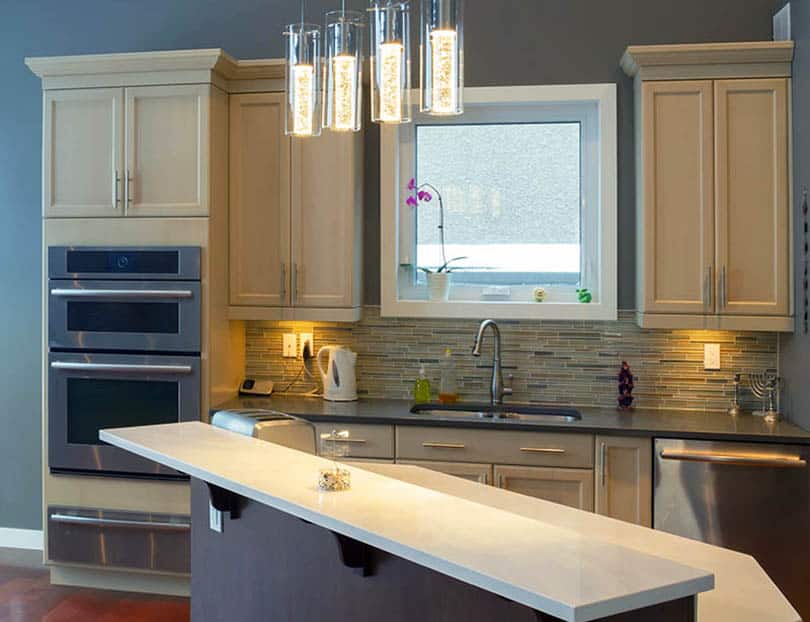
There are specific shades of blue that work best for a kitchen setting. When used for walls, lighter shades of blue, such as powder and sky blue, can help create a clean, crisp look for a kitchen. Darker shades of blue can also be used for walls to create a more dramatic look, as long as it is balanced out and accentuated with hints of neutrals like white and shades of gray to prevent it from looking too intense or heavy. The color blue, in general, will work best in a kitchen setting, especially when it is used sparingly, and the walls are a good way to introduce it to a space.
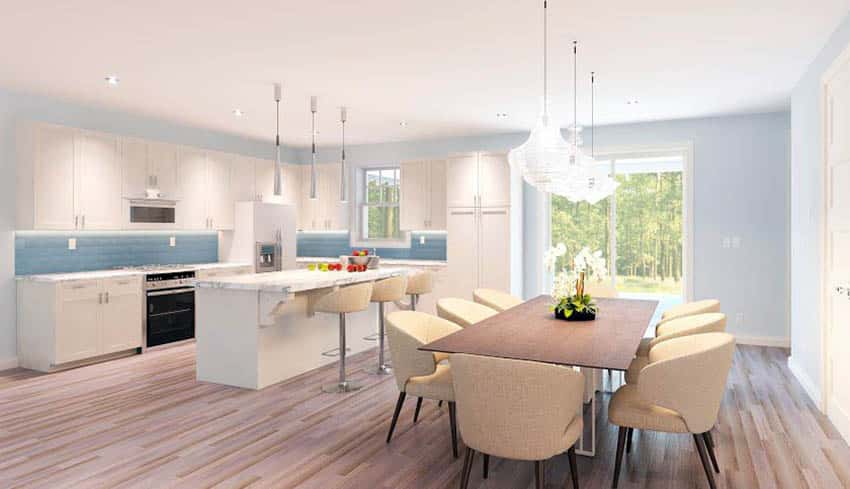
In general, blue walls can add an invigorating touch to a kitchen. However, when using this color, make sure to use it in limited amounts, as it has the tendency to overpower a room.

Inspired by the color of nature, plants, and trees, the color green can lend an organic, earthy vibe to a kitchen space. Painting your kitchen walls green can produce a soothing atmosphere and a refreshing feel. A green wall also pairs well with white accents, shades of brown, and other wood finishes.
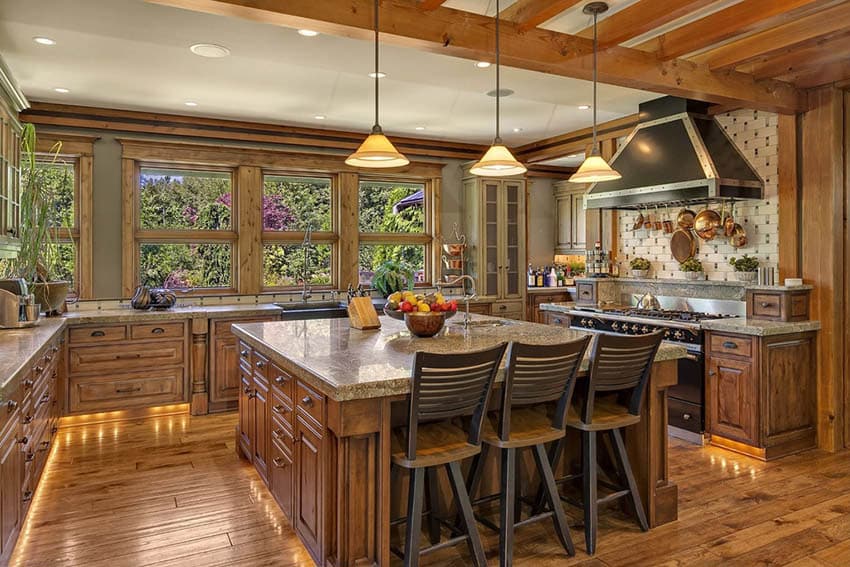
Best warm colors for kitchen walls
Warm hues such as red, yellow, and orange are popular wall colors for kitchens because of their ability to stimulate the appetite and promote hunger. For those who want to create a warm, inviting atmosphere for your kitchen, these colors are your best bet.
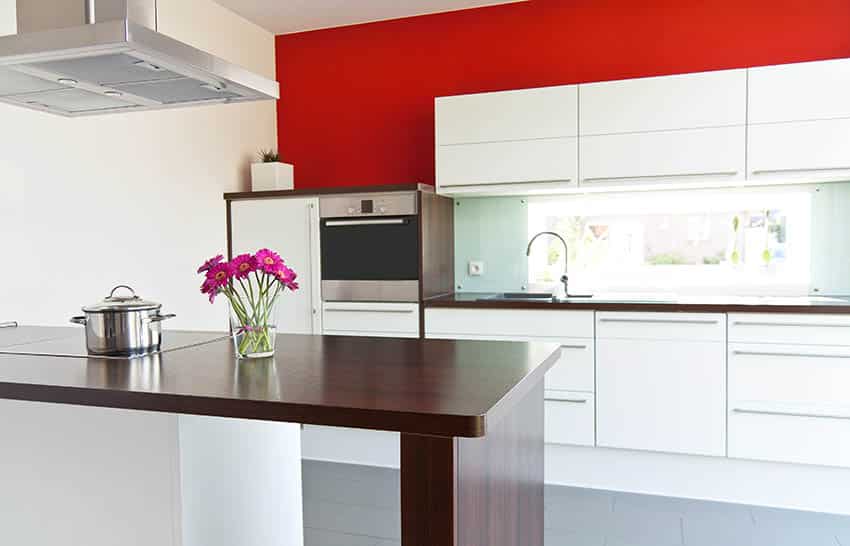
Typically, red is used if you want to add spice to your kitchen walls. It can keep a kitchen from looking too gloomy and can instantly liven up a color scheme that is dominated by neutral-colored cabinetry, countertops, and flooring. A red accent wall can also serve as a focal point in a kitchen. It works well, particularly when combined with stainless steel appliances and white or gray kitchen cabinets.
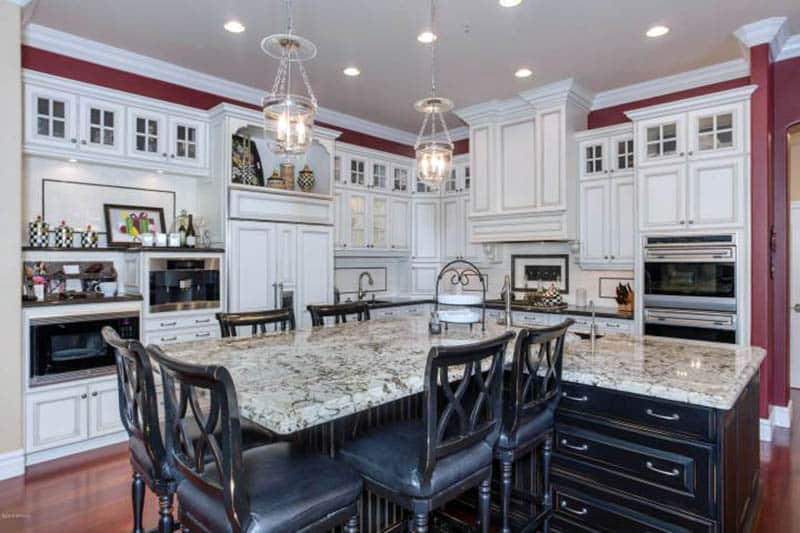
Red walls are incredibly versatile and can be combined with a variety of kitchen cabinet styles and countertop choices. However, it is a bold color, and going with a red wall can be a bit tricky to pull off. If you are using red as a color for your kitchen’s wall, make sure you do it right if it is not used sparingly; it may look too overwhelming and dark.
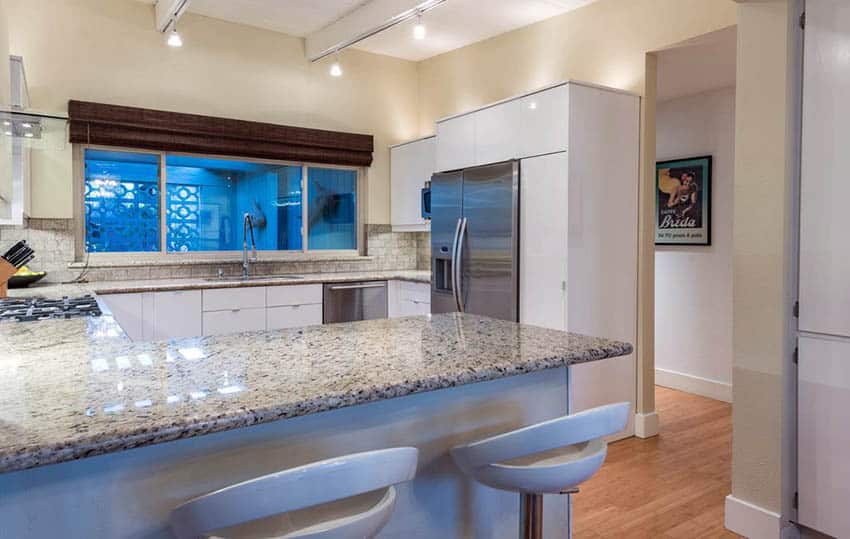
Just like red, yellow is also believed to be an effective appetite stimulator. A yellow wall can instantly make your family or even your guests feel happy, but it can also make them experience calm. In addition to the pop that it can contribute to color palettes, a yellow wall can also make your kitchen feel energized. Like white walls, yellow walls help reflect the maximum amount of light in a space, so they also have the effect of making a kitchen feel less gloomy and more bright.
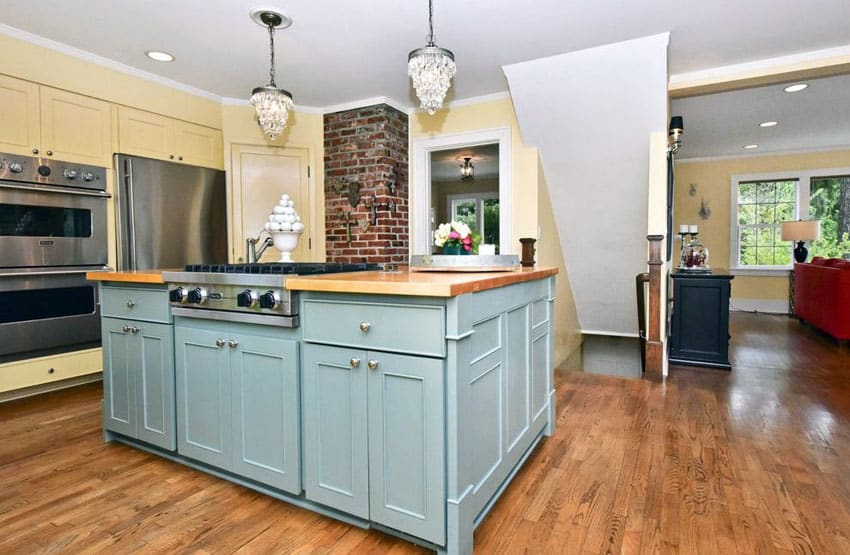
Yellow walls perfectly pair with most types of kitchen cabinet wood species and can complement white kitchen cabinets as well. However, the real beauty of yellow walls stands out when juxtaposed with shades of gray, especially the muted ones. The color yellow not only works as a wall color for kitchens but can also be introduced as a backsplash material, as an accent color for accessories, or even for the inside of the cabinets.
What to avoid for kitchen wall colors
When choosing the right colors for your kitchen walls, it is best to generally avoid colors that can make the space feel gloomy or too heavy on the walls. As mentioned, the kitchen is considered to be the heart of the home, and it is where you often gather with family and friends. With such in mind, your main goal should be to promote a welcoming yet relaxing ambiance. Black and other dark colors are typically not suited for this type of application; however, when used as sparingly as possible for an accent wall or as a contrasting element to light cabinets, countertops, and floors, this can still result in a unique color scheme for your kitchen.
Best Kitchen Paint Colors for the Living Room
Both the living room and the kitchen are places for congregation. Whether for family dinners or gatherings with friends, these two spaces are the primary areas that we frequently showcase to other people. With such, it is ideal to present them in the best way we can to make your guests feel at home and welcomed. And with the amount of time that we, homeowners, spend in them, it is equally important that we design them to be relaxing and inviting.
One of the easiest ways to bring out the best in our living and kitchens is to give them the right color palette. It is common knowledge that colors can help influence our moods, and choosing the right paint colors can affect the way we feel toward these spaces and the way we use them.

Here are some of the best paint colors for living rooms and kitchens:
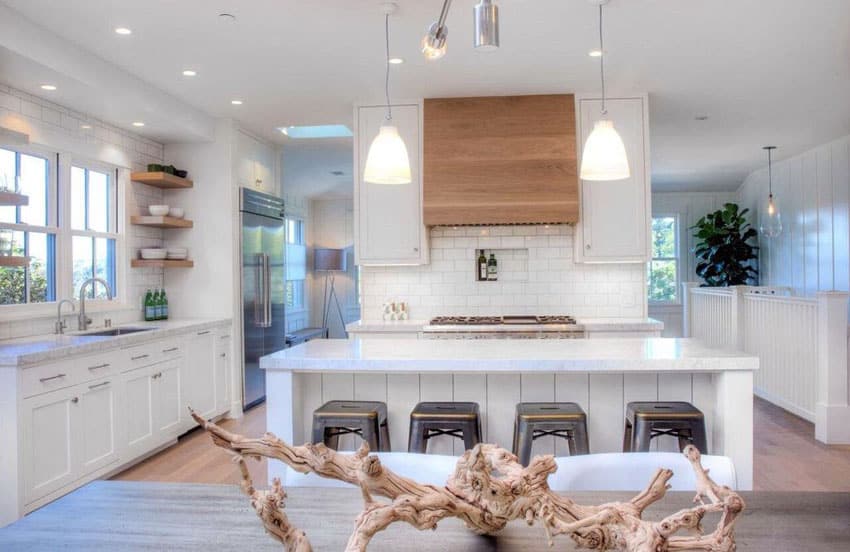
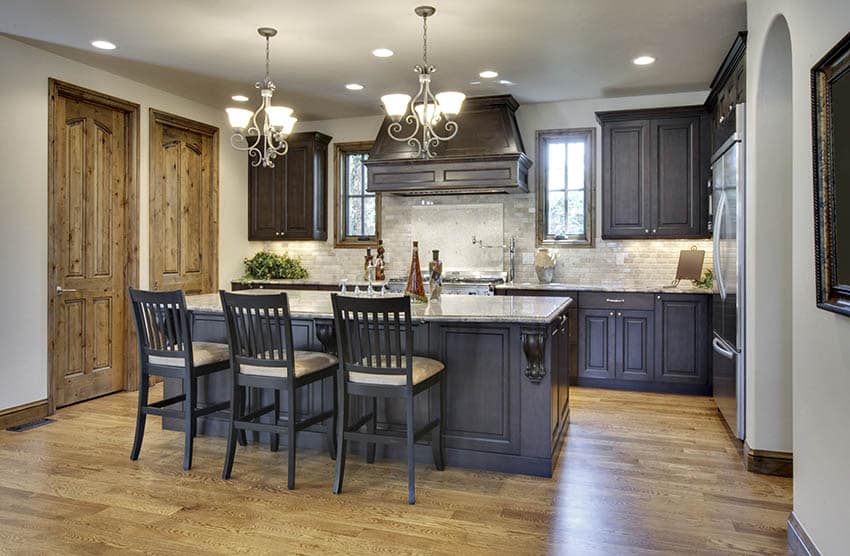
Try: Cappuccino White by Glidden

Try: Aged Beige by Behr
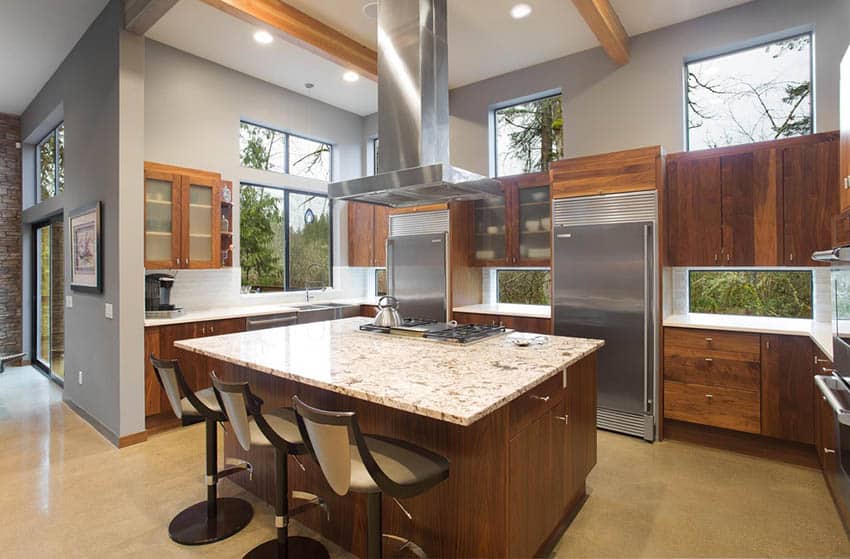
Pale grays also pair well with whites and can help highlight these features without too much contrast. Also, pale grays are more compatible with a variety of other colors, so it gives you maximum creative freedom to experiment with your decor and accessories. Pale grays can also serve as a perfect backdrop to any style – whether it may be classic, modern, or contemporary. It is one of the best colors to paint adjoining living rooms and kitchens since it can create a continuous, spacious look without being too sterile.
Try: Crushed Ice by Sherwin Williams
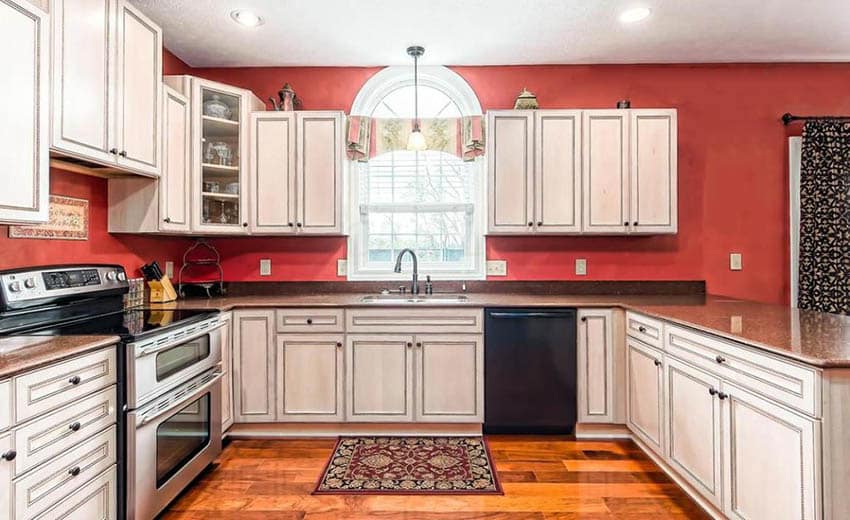
A warm and vibrant living room color such as red, can easily give your whole house a wake-up call. You can either paint all the perimeter walls in this strong color or, alternatively, set out one wall as an accent wall and pair it with a medium-toned neutral wall color. Ideally, if you have a bold wall color, you need some sort of element to balance it. Avoid pairing it with since it can create a very stark contrast in the space.

Try: Ablaze by Sherwin Williams
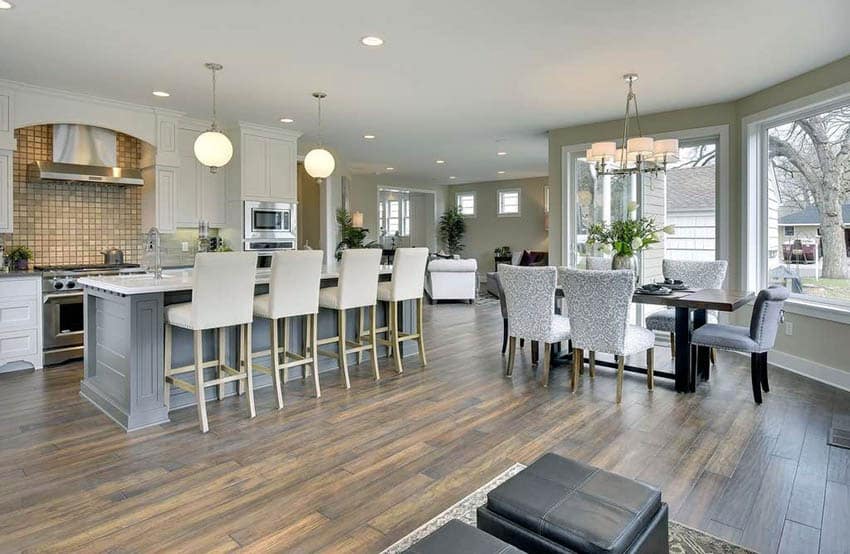
Also, if you love traditional styles such as comfortable lodges, cozy country, and Craftsman kitchens, green is also one of the best paint colors you can explore for your living room and kitchen. Some of the best-muted shades of green for living rooms and kitchens are Russian green, fern green, and muted olive.
For more ideas, visit this page to see foyer paint colors for a cohesive design for connecting your entryway to your living room space.
Best Kitchen Cabinet Paint Colors
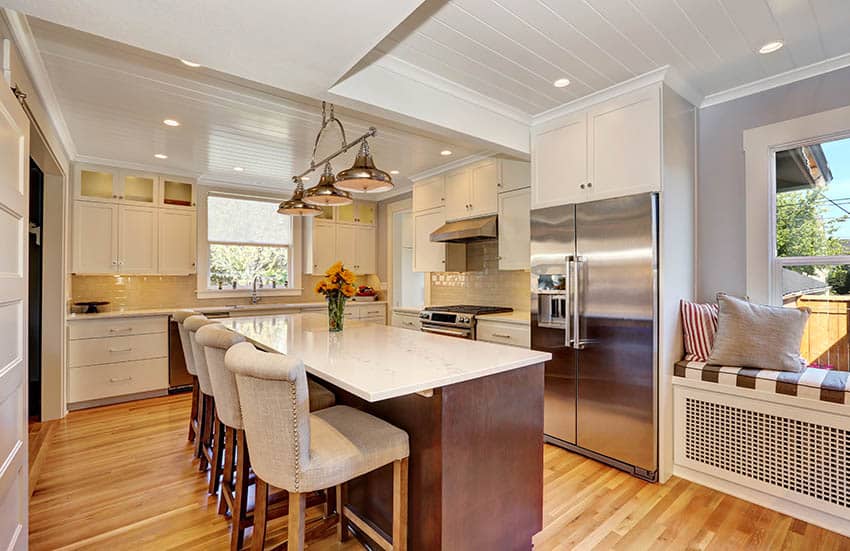
The paint color of your kitchen cabinets can have a major effect on the overall look of your kitchen. Because of the dominance, most homeowners tend to decide on the paint color for the kitchen cabinets first to set it as a foundation for the rest of the room when formulating the final color palette for a kitchen. The common design approach will often involve contrasting the colors of the wall and the cabinet colors. For example, if you choose a bold shade for your kitchen cabinets, such as red, balance it out with a light gray wall, or vice versa. In some cases, homeowners just tend to go with a classic all-white palette for their walls and kitchen cabinets to produce a clean and bright look.
There are lots of colors that work well on kitchen cabinets, and for every specific type of color, each paint manufacturer can produce their own numerous versions of it. And since design is mostly based on one’s preference and taste, any color can be used to produce a unique kitchen cabinetry style for a home. If your kitchen cabinets are painted in a color that you do not particularly love, chances are you will eventually get tired of them and want to repaint them in time.
Before selecting your final kitchen cabinet color, it is important to take into account several factors and visual elements in the room. Choose a color in relation to the countertop material, wall paint, backsplash finish, floor, and appliances. Also, consider the prevailing style of your home and the cabinet design that you already have or plan to use. In general, traditional kitchen designs could go for classic cabinet colors such as white and beige.

Also, a good guide to keep in mind when choosing the best color to paint kitchen cabinets is to stick with neutrals if there is already a lot of color in the room. While it is safe to use white and go with wood finishes, there are still other colors that one can explore to make a stunning kitchen cabinet design. Here are some of the best colors to paint kitchen cabinets:

There are many different shades of white paint to choose from, ranging from crisp, bright tones to creamy ivory to warm beiges, and all of which can be used to finish a variety of kitchen cabinet styles, whether it may traditional, cottage country, transitional, farmhouse, contemporary or modern.
For traditional kitchen cabinet designs, opt for white paint, which leans towards a warmer undertone, such as beige and cream. You can either have them in a stain finish or ask a professional to apply them using special techniques such as distressing, antiquing, and weathering to give them a more time-worn feel. For contemporary, modern, and minimalist kitchen cabinet designs, go with the brighter whites to create a more airy atmosphere and a simple aesthetic. Also, opt for an ultra-polished and smooth finish for that sleek look.
Try: Simply White by Benjamin Moore, Dove White by Benjamin Moore (warm white), Chantilly Lace by Benjamin Moore (crisp white), Alabaster by Sherwin Williams (soft white)
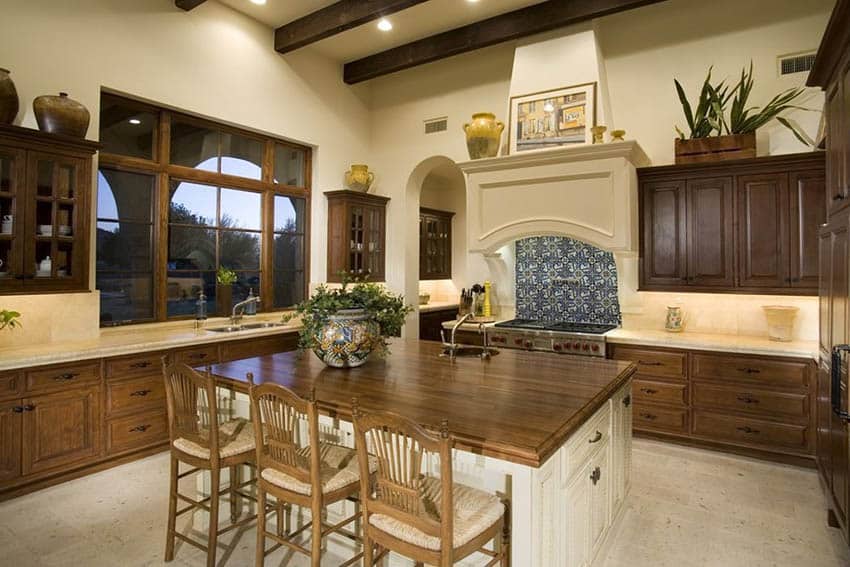
Most people gravitate toward wood finishes and shades of brown for their kitchen cabinets because they can complement a lot of different colors. Whether you plan on blending your kitchen cabinets with a monochromatic color scheme or plan on contrasting them with the rest of your color palette, a good shade of brown can help you do the trick. Wood finishes, whether light or dark, helps project a cozy and inviting atmosphere. In addition to this, allowing the inherent color of wood to stand out also enhances the natural warmth that it can bring into a space.

If black paint does not suit your taste, you can also explore other dark shades that belong to the same spectrum. Look for paints that have a hint of gray to help diffuse the heaviness. Examples of these are charcoal, graphite, and iron.
Try : Black by Benjamin Moore (traditional black)
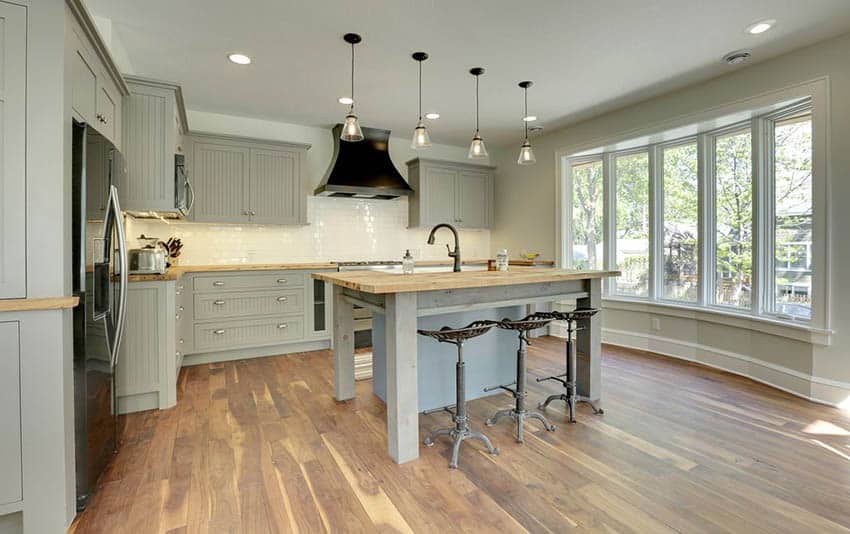
Various shades of gray work well as paint for kitchen cabinets and can help ground your space, providing creative freedom and allowing for more options in countertops, wall color, and flooring. In addition to their flexibility, gray kitchen cabinets also offer more opportunities to incorporate other colors into a kitchen’s color palette, whether they be warm or cool accents.
Gray kitchen cabinets also provide a sleek and sophisticated look for modern kitchens. When paired with the right countertop, it can allow kitchen accessories to pop out. The moody color of gray kitchen cabinets can also help bring drama into a space without being too overwhelming. Lighter shades of gray can help create a more casual and comfortable kitchen atmosphere, while warm shades of gray can be used as a statement-making color in a space.

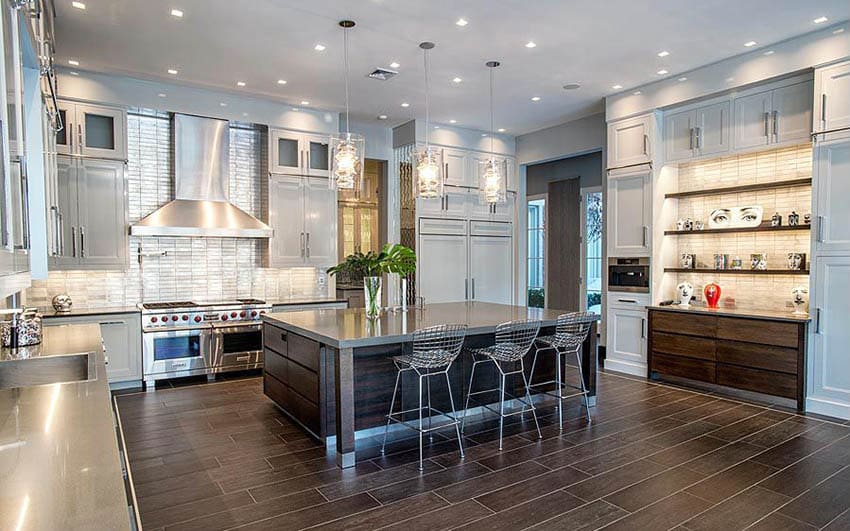
Try: Gray Owl by Benjamin Moore (slightly warm gray undertone), Dovetail by Sherwin Williams (deep warm gray), Knoxville Gray by Benjamin Moore (bluish gray with a hint of green), Gauntlet gray by Sherwin Williams (deep charcoal gray), and Argos by Sherwin Williams (light gray with green undertones)
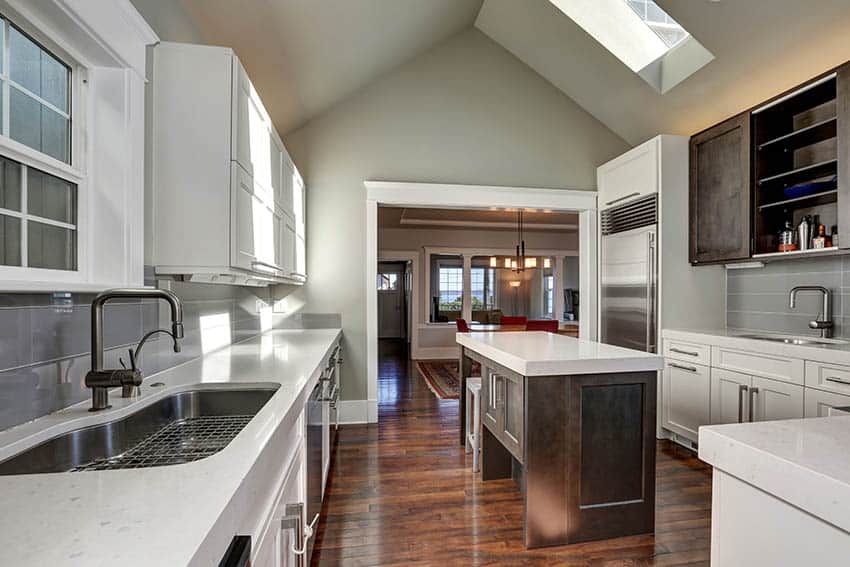
Greige works well as a kitchen cabinet color because it projects the perfect balance of cool and warm. Greige is also available in various tonalities. It can be adjusted into different levels to make a cool or warm neutral. The more it becomes leaned toward gray, the cooler it gets, while the stronger the presence of a beige undertone, the warmer the greige becomes.
Greige kitchen cabinets adapt well to any color scheme. It is easy to introduce and accent color or complement hue in a kitchen, depending on the intensity of the gray tones in your greige cabinets. Greige kitchen cabinets that are more gray are best paired with cool hues such as blue and white for a refreshing kitchen color scheme. While greige kitchen cabinets that have more beige undertones work best when complemented with dark wood finishes. This color of kitchen cabinet is also best paired with gold hardware and looks extra inviting and lively when combined with bright yellow accents and accessories.
Try : Agreeable Beige by Sherwin Williams, Revere Pewter by Benjamin Moore, and Granite Boulder by Behr

Navy blue kitchen cabinets also offer flexibility and versatility in more ways than you can imagine. Similar to a trusted pair of dark jeans, navy blue kitchen cabinets can be paired with almost any accent color and can work their way into any kitchen style and setting. Although it may not be as flexible as the popular neutrals, navy blue kitchen cabinets are workable into a new color scheme and look extra stunning when balanced out with a shade of gray or a contrasting yellow accent.
Other shades of blue that work best as a kitchen cabinet color are light powdery blues and beachy blues. Muted blues and light blue kitchen cabinets produce a more toned-down appeal compared to navy blue and are perfect if you want to evoke a strong, refreshing vibe and coastal comfort in your kitchen.
Try: Hale Navy by Benjamin Moore (perfect navy blue color, deep and moody), Hague Blue by Farrow and Ball’s (very dark navy blue), Indigo Streamer by Valspar (teal undertone)
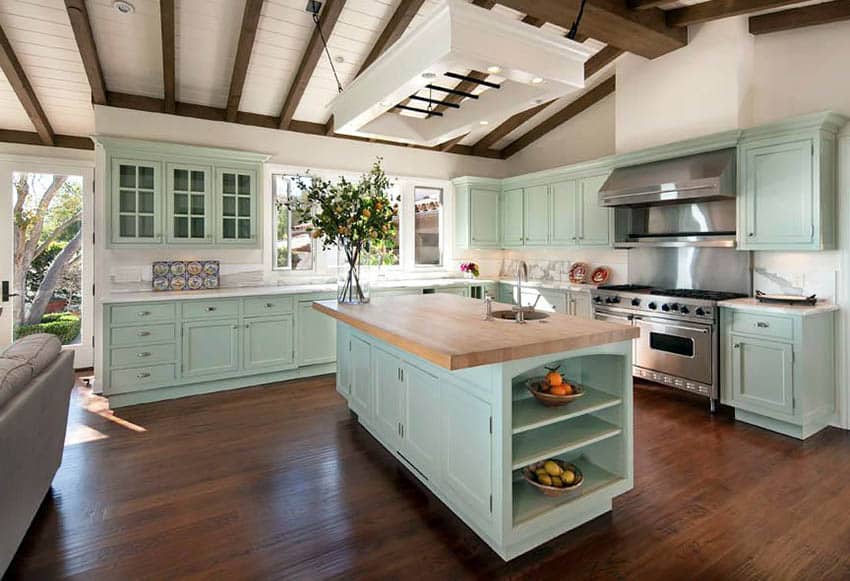
Various shades of green can be explored as a kitchen cabinet color, depending on the prevailing style of your home. Lighter greens, such as mint green, are perfect for charming cottage kitchens; muted greens, such as shade and olive green, also work for country kitchens but can also be used for contemporary kitchen settings, while bright and bolder hues, such as lime green are well suited for playful modern kitchens. Darker colors such as emerald green and hunter green can really make a statement on kitchen cabinets, but they work best in large spaces since they have the tendency to darken small rooms. If you plan to use them in a tiny kitchen, make sure to balance them out with light-colored walls and accessories.
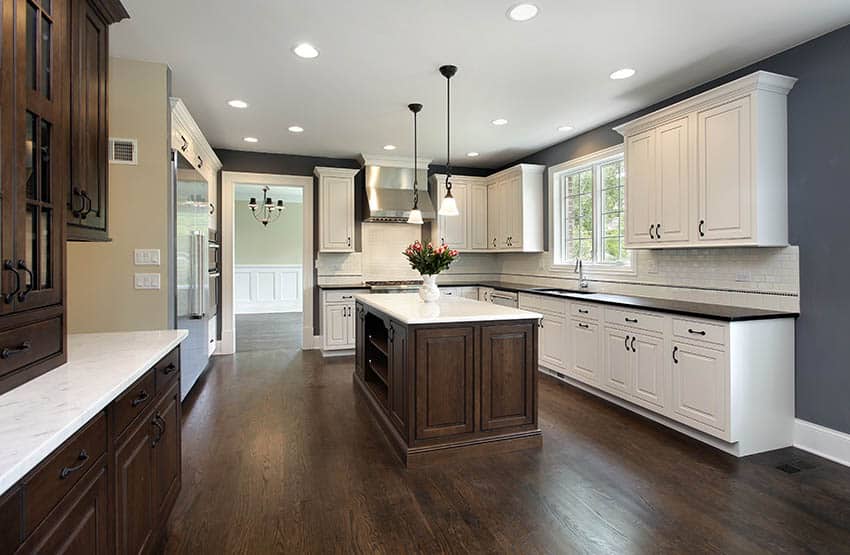
The simple trick to pull off this look is to paint the top drawers in a light color and the bottom in a darker one. This stellar combination helps ground the space. You can take a single hue and paint a lighter version for the overhead cabinets or take it a shade deeper for the bottom cabinets. You can also paint your kitchen island in a different color, if that suits your taste. The two-tone effect helps the kitchen not be overpowered by one single hue.

Nowadays, you see homeowners paint their overhead cabinets with a soft shade of cool gray while their base cabinets are finished in a light, buttery yellow (for classic settings) or a cheery mustard yellow (for contemporary kitchens). Dark neutral hues such as taupe, charcoal gray, and black are also commonly paired with warm tones such as terra cotta or sage green. Other popular combinations for the two cabinets include cool and warm gray, natural wood tones, and black, gray, and green. When it comes to this design approach, there is actually no limit to the color choices.
Best White Paint Color for Kitchen Cabinets
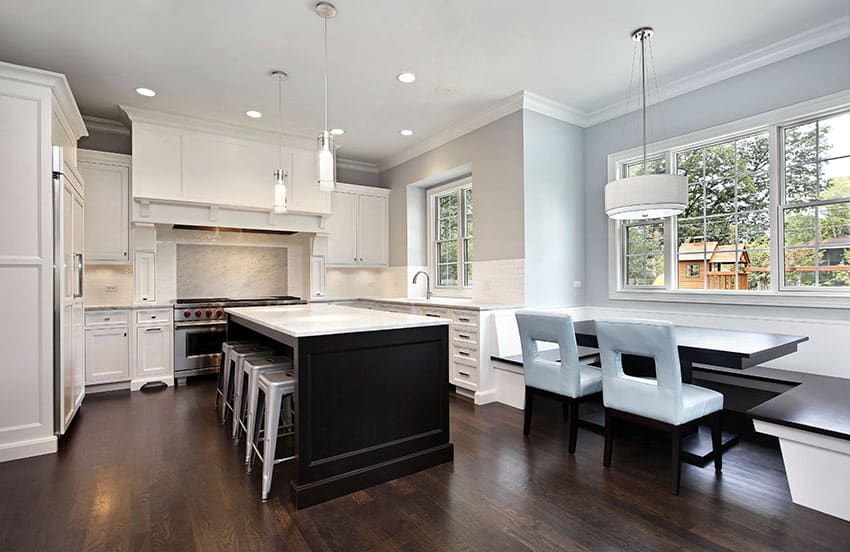
The truth about white paint is that they are not created equal. There is no such thing as “pure white” when it comes to paint colors. There are thousands of white paints to choose from in the market. A single paint supplier can produce as many as hundreds of tints and shades just for the color white. For example, Benjamin Moore has a compilation of 152 paint shades for the color white and off-white alone. Imagine combining that with all the brands available in the market. In addition to the wide array of choices, the color white may have different undertones and versions to make them more appealing and to give them an added visual interest.
There are several factors to consider in choosing the best white paint color for your kitchen cabinets. The first step to selecting the perfect white for kitchen cabinets is to decide on the undertone you want to stand out. White paint colors may have some tinges of blue, yellow, gray, peach, or brown. However, generally light and airy, white paints can either be cool or warm. More often, the undertones in white paint are not that obvious at first look, but once applied to the cabinets and placed alongside other design elements in the space, like the countertops, walls, flooring, and backsplash, you can see the undertones come to life.
Lighting also plays an integral role in selecting the right white paint for your kitchen cabinets. As mentioned, lighting greatly affects the way a color is perceived. A specific white paint can look different when you look at it in the showroom versus using it at home. Your final white paint selection will look different under artificial cool white light, daylight, warm white accent light, and natural lighting. More often, a home improvement store will use bright fluorescent lighting, causing a different effect on the real color of the white paint, whereas at home, the lighting used is a combination of natural sources and ambient lights, thus producing a different color. With that, it is more advised to view your cabinet paint samples at home as it gives you a realistic preview of the final results.
The prevailing style of the kitchen and the design of the cabinets are also significant in choosing the best white paint for cabinets. Traditional kitchen settings and elaborate cabinetry tend to go with warmer undertones of white, which include alabaster, beige, ivory, and cream. At the same time, modern kitchens with minimalist cabinetry design are geared towards brighter whites such as ultra white.
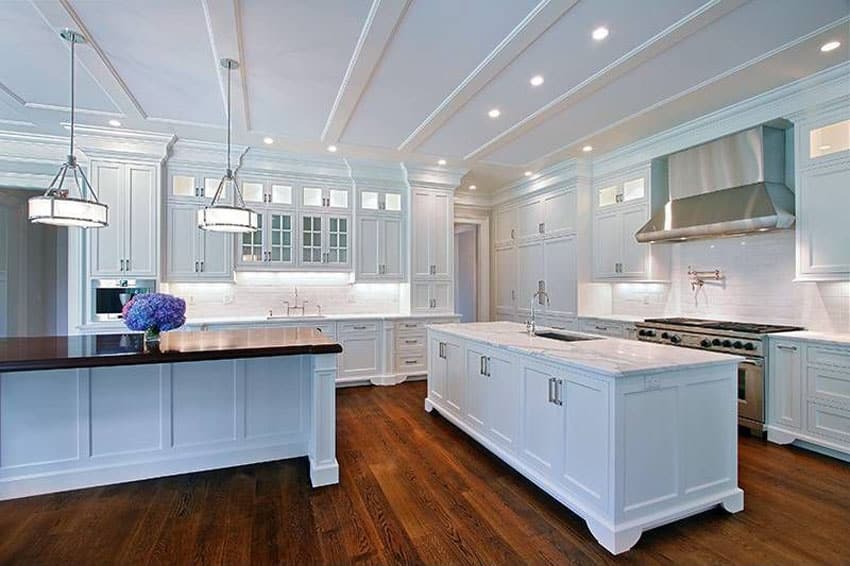
- Super White, by Benjamin Moore – Formerly known as Super White PM-1, this paint color is a part of Benjamin Moore’s off-white collection. Described to be not too warm nor too cool, Super White is inherently sophisticated and serene. Super White is best used for lacquered white cabinets and can be used for both traditional and modern cabinet designs.
- White Dove OC-17, by Benjamin Moore – Characterized as a classic, softly shaded white, White Dove is one of the best white paint choices for traditional-inspired cabinetry.
- Chantilly Lace OC-65, by Benjamin Moore – A delicate and refined version of white, which is almost similar to lace, this crisp, clean white is the perfect white paint for cottage and country-style cabinets.
- Silky White, by Behr – A warm take on white. Silky White is the perfect cabinet color if you want a cool palette with some depth. Its color has tinges of gray and taupe undertones, making it a classy choice for contemporary and modern-style cabinets.
- Navajo White, by Sherwin Williams – A creamy shade of white perfect for vintage-inspired cabinets.
- Seaside Resort , by Benjamin Moore – This light and clean shade of white is the perfect choice for cabinets placed against a bold color palette. It can introduce a strong visual relief for bright kitchens.
- Dover White, by Sherwin Williams – This soft and soothing shade of white suits vintage-style cabinets.
- Silver chain, by Benjamin Moore – If stark white paints are not your cup of tea, this grayish white is the perfect finish to contemporary cabinet designs.
- Swiss Coffee, by Valspar – An antique white shade, Swiss Coffee paint can be used to evoke a vintage feel in your cabinets.
- White Tie, by Farrow & Ball – An off-white shade with the right touch of cream. Containing just the right amount of yellow undertones, this paint color can help warm up your cabinets and produce a welcoming atmosphere for your kitchen.
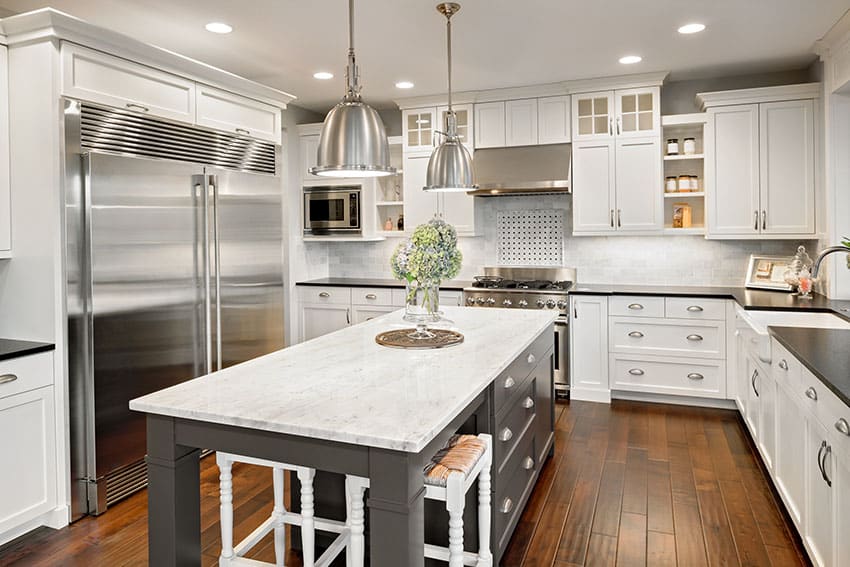
- Pure White SW-7005, by Sherwin Williams
- White Heron SW – 7627, by Sherwin Williams
- Shoji White SW – 7042, by Sherwin Williams
- Marshmallow SW-7001, by Sherwin Williams
- Big Chill, by Sherwin Williams
- DKC-67, by Donald Kaufman Color
- White Diamond, by Behr Paints
Kitchen Colors to Match with Dark Cabinets

With the endless shades and colors of paint that are available in the market, it is impossible to find not only hundreds but even maybe thousands of shades to work with dark-colored cabinetry. A lot of paint colors will work with dark-colored cabinets. It just depends on the visual attribute and effect you want to achieve for your kitchen. Light-colored paints can help tone down the richness of dark cabinets, while dark-colored paints can help enhance their luxurious look.
To minimize confusion and the stress of choosing between the broad spectrum of colors that can match dark-painted cabinets, a good tip to keep in mind is to use the undertones present in the wood as your color guide. No wood is just plainly solid brown in color. It is never just dark brown, tan brown, or plain espresso. If you examine it closely, you’ll find that wood has a base color with tinges of hues embedded in its surface – whether from the natural wood grains, mineral streaks, or even the stain used to finish it.
Cherry wood, for example, has reddish undertones, oak has yellowish undertones, etc. In general, dark wood with warm undertones usually has inherent reddish tones, an orange tinge or a yellowish base. While wood with cool undertones typically has varying shades of gray cast over its surface. The general rule is to opt for paint colors that belong to the same color temperature. For dark wooden cabinets, the undertones present in the natural color of wood or the stain color of the material can be used as a complementary wall color.
Here are some of the best paint colors for kitchens with dark cabinets:
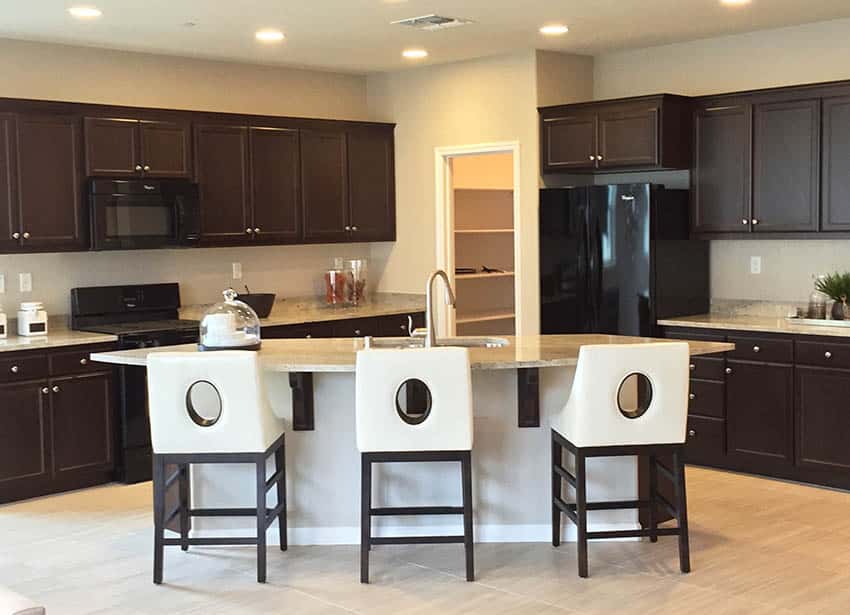
White and brown, or white and any dark color, has been considered as a classic pairing for many interior applications. Combining white can help balance the richness of any dark-painted cabinetry. When paired with dark wood cabinets, white walls can help enhance the undertones of wood, making it appear brighter.
Beige is another neutral that can be used as an alternative to white. For some homeowners, white walls can look a bit too dull, plain, or even too sterile. Beige has a creamy tone with a slight tinge of yellow. The presence of this slightly yellowish tint gives beige the right balance of warm and cool undertones. Compared to the bright, crisp appearance of white walls, beige walls have more warmth. Combined with dark-painted cabinets, beige walls leave a cozy and inviting atmosphere. It can work the same wonders as a white wall can, making a space appear more spacious.
White and beige paint can be used in different ways depending on the kitchen style. If working with a traditional and country-inspired setting, opt to pair dark wood cabinets with beige walls. If working with a more contemporary or modern setting, opt to pair dark cabinets with brighter whites. The combination of dark-colored cabinets and bright white walls is prevalent in most modern minimalist designs because it exudes simplicity. This classic color combination also provides the perfect opportunity to introduce splashes of colors into the space.
White or beige paint also does not compete with the richness of dark wood cabinets. If you want to make your dark cabinetry the focal point of the space, then this is the best paint color you can explore. Also, if you have limited space and want a paint color that will make the space appear less heavy on the eyes, and more spacious, white and beige paint is also your best bet.
There are also some other shades that belong to the same color family, which can go well with dark cabinets. Aside from white and beige, other best paint colors that can contrast with dark-colored cabinets are off-white, cream, ivory, ecru, pearl, alabaster, seashell white, and frost white, to name a few. You can ask your local paint supplier for more options that will fit your personal taste and style.
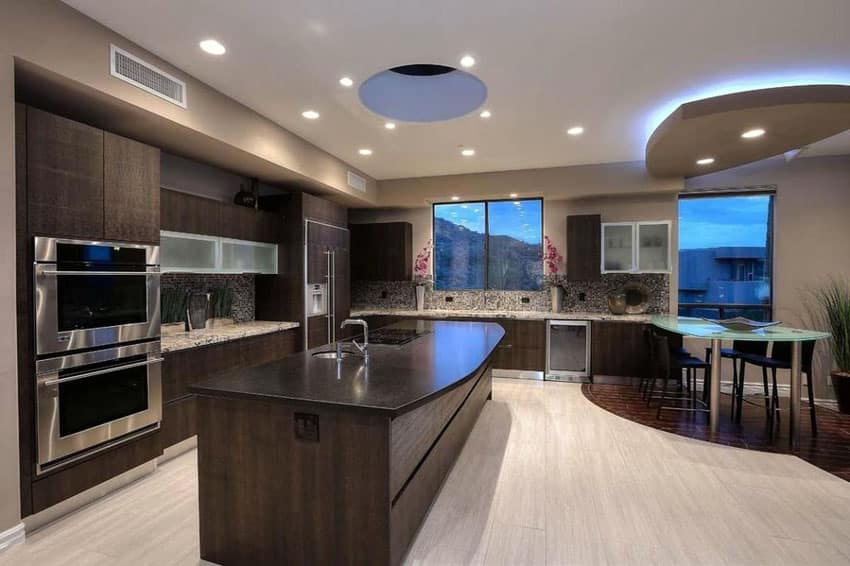
Dark wood finishes and brown paint provide the perfect opportunity to create a monochromatic color scheme for kitchens. A monochromatic color scheme makes use of one hue in different shades and tints. Using a monochromatic color scheme does not necessarily mean that you have to stick with one exact hue of color and repeat it over and over for all the finishes in the space. You can take a single color and either tone it down to a lighter tint or adjust it to a darker shade. For example, if you have dark espresso-colored cabinets, then you can use light mocha for the walls and light-colored wood for the floor. Sticking with one hue of color, for this case, shades of brown, produces an overall look that is harmonious.
To produce a well-balanced layering of color, dimension, and a less boring monochromatic scheme, make sure to combine the right intensities of color for the walls, cabinetry, flooring, countertops, splashboard, and accessories. Diversity and variation in texture and finishes can also help prevent your kitchen from looking too dull.
For an effective monochromatic color scheme, combine dark wooden cabinets with paint colors that have light to mid shades of brown. Opt for light mocha, tan, or sand, and do not go with a very dark shade, such as chocolate brown or hickory, since it has the tendency to camouflage dark wood finishes. For traditional designs, go for lighter shades of brown or gold paints since they can tone down the heaviness of rich millwork and deep-colored cabinetry.
In general, paints in shades of brown paired with dark cabinets are ideal for kitchens with large spaces and with open layouts.

The beauty of deep and rich tones is that they can contribute a pop of color to a space without being too intense and overwhelming. Deep-colored walls paired with dark-colored cabinets give the natural richness of wood a more luxurious feel and also create drama in a space. Typically, this color combination is more geared toward a traditional look like historical houses, old-world houses, or country kitchens because it does not deviate from the formality of a space.
However, using deep tones as a primary color for the walls can be a bit tricky to pull off. Since your cabinets are also dark, you need some sort of balancing element to prevent the space from looking too gloomy or heavy. Introduce a light-colored visual element to break off the color scheme, whether through the countertops, flooring, or backsplash material. Also, go for the right intensity of color. For the same reasons, the ultra-rich pairing of deep-toned wall paints and dark-colored cabinets is more suited for large kitchens, as they have the tendency to make small spaces feel more cramped.
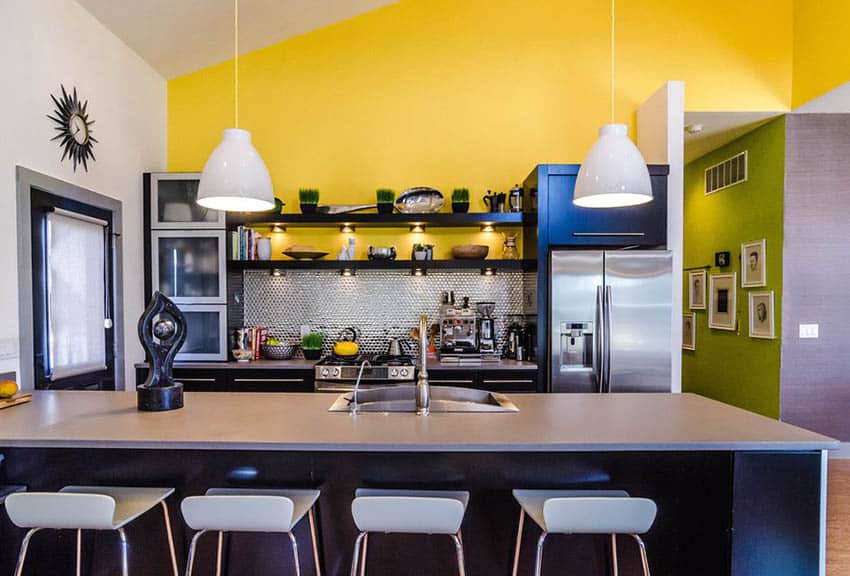
Popular bright colors that can work well with dark cabinetry include saturated versions of green, red, and yellow – which are basically hues derived from primary and secondary colors. Some examples of bright colors include rust orange, mustard yellows, lime green, or apple green. If you can notice, these colors are more commonly used for modern and bold contemporary kitchen settings.
The key to pairing bright colors with dark cabinets is to create balance. Bright colors must be used smartly in a space. Otherwise, they have the tendency to become too shocking. For example, a bright shade of paint used for the wall may be used sparingly for matching accessories like appliances, light fixtures, accessories like pots or pans, or as an accent color for the splashboard. Alternatively, your chosen bright and bold paint color can also be mirrored in a contrasting center island or as paint for windows and doors for a modern vibe. Also, note that the playful combination of dark cabinets and bright paint colors for the walls is ideal for kitchens with abundant natural and artificial light.

Among the pastel colors, the best paint color that works for dark cabinetry is soft yellows, as soft yellow walls can easily liven up a space and brighten the color of dark cabinetry. It creates a cheery ambiance and works best for adding charm to cottage-inspired kitchens. In addition, pastel shades of yellow can also be used as a wall color for small kitchens since they tend to make small spaces appear bigger. In addition to this, pastel yellow walls also do not compete with the richness of dark wood cabinets and can be used if you want to make your cabinets the focal point of the space. This paint color is not highly suited for dark wooden cabinets, but it can be used to complement dark gray or charcoal cabinetry.
To create a cohesive overall look for your kitchen, opt for the lightest shade of yellow for the wall, then take this color and mirror it as a darker tone for your backsplash, accessories or window treatments. This approach produces a more balanced layering of color.
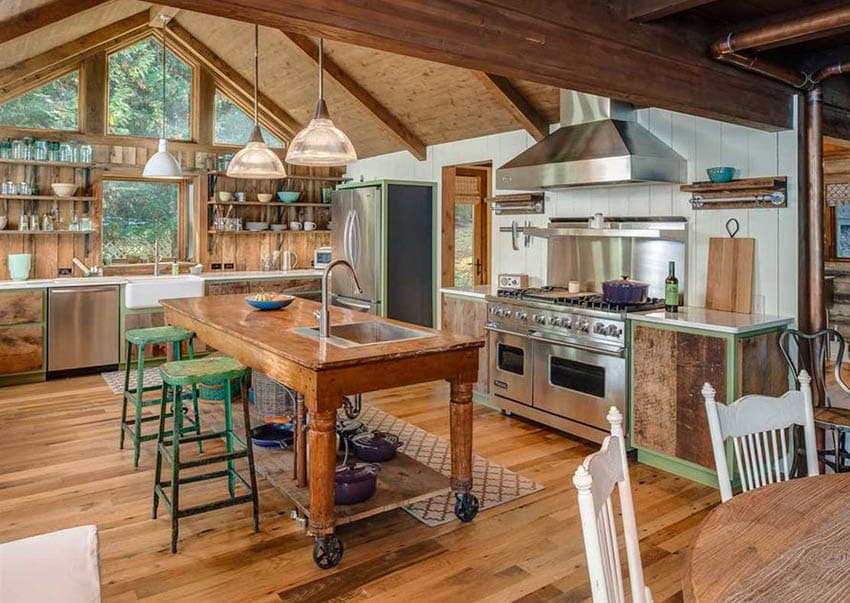

Soft grays come in a variety of tonalities and are a good base color, making mixing and matching accessories easy. Although subdued, a soft gray paint for walls paired with dark-colored cabinets can help create a dramatic effect in a space. It is mellow, not overwhelming, yet can add depth and dimension to a space. Paired together, soft gray walls and dark-colored cabinets can produce contrast.
Dark grays can also be used as a paint color to go with dark-colored cabinets, as they also blend beautifully together. Although more popular in modern and contemporary settings, the combination of dark wood cabinetry and soft gray walls can also be used for traditional and transitional kitchens.
Colors That Pair Well with Oak Kitchen Cabinets

It is not hard to see why many people are drawn to the inherent beauty of oak cabinets. Oak has a warm, golden hue and an interesting, open, uniform, fine-graining pattern that is distinguished by light-reflecting rays.
Choosing the right paint color to go with oak kitchen cabinets is quite tricky. Although generally classified as a yellow-toned wood, oak has varying undertones, which range from beige to gold, and sometimes pickups reddish tinges to flashes of pink and orange. Oak wood is also generally harder to tone down but is pretty easy to accentuate. Before you choose the final paint color that you want your oak cabinets to go with, you have to decide whether you want to blend your cabinets with the rest of your color palette or you want to accentuate it and make it a focal point of the space. Here is a good guide to use in choosing the right paint color for oak cabinets:
- Oak wood has a warm undertone to it, and if you want to accentuate warm woods, use cool colors and neutrals with cool undertones such as gray, white, blue, green, and purple. Paint colors that are a few tones lighter or darker than oak wood can also help accentuate its features.
- To downplay the warmth of oak wood and tone it down a bit, use warm colors and neutrals with warm undertones such as beige, cream, brown, and greige. Sticking with paint colors that have a similar depth to your wood will create a more seamless look.
Here are some of the best paint colors to coordinate with oak kitchen cabinets:
Paint colors to accentuate oak wood cabinets (contrast)
Green – Green paint can help tone down the warmth of yellow-toned woods. Depending on the intensity of the green, you can create a whole new look for your cooking area with oak cabinets. Lighter shades of green, such as mint green and sage green, help render a calming and refreshing feel to a space, while darker greens, such as olive and hunter green, produce a richer and more luxurious look. Muted greens, on the other hand, are your best bet if you want to give your oak cabinets a more updated vibe. Together, this winning color combination is naturally organic and cozy.
Shades of blue – Blue is one of the best contrasting colors for oak cabinets. This calming color can easily match with yellow-toned wood, regardless of its shade, whether it may be rich navy blue paint, a muted bluish gray shade, or a very light powdery blue hue. Light blue paints can help contribute a breath of fresh air and a whimsical pop of color to a room with warm oak cabinets. Shades of blue can also enhance oak wood and offer a great way to give it a more updated look.
Neutrals such as gray and white with cool undertones – Neutrals such as white and gray with cool undertones of green and blue also help accentuate the golden hue of oak cabinets. But at the same time, it creates a fresh and bright space. These colors can help balance out the space while also allowing your oak cabinets to stand out.
Try :
- Gray Cashmere 2138-60, by Benjamin Moore ( soft gray with bluish-green undertones)
- Silverplate, by Benjamin Moore (cool gray with a hint of bluish undertone)
- Sea Salt SW 6204, by Sherwin Williams (light green paint with a bluish-gray undertone)
Paint colors to tone down the warmth of oak wood (blend) :
Beige – Beige shares the same color temperature with oak cabinets as both have a warm yellow undertone to them. With a beige paint color, you can easily blend oak cabinets into the rest of the room. Staying on the lighter side will also produce a brighter look for your space. The yellow undertones of beige walls can also help make a room feel cheery.
Greige – Greige has the foundation of a subtle gray base with a solid beige undertone. This paint color is one of the best colors for neutralizing light oak cabinets. Greige walls and oak cabinets help create a well-balanced overall look for a space that is equally cool and warm.

Cream – Cream is a warm shade of white with “butterscotch” or almost yellowish undertones. Similar to gray, this paint color also stands neutral with oak as it won’t entirely accentuate the yellow tone of the wood, but it won’t camouflage it either. Together, cream-colored walls and oak cabinets help create a room that is naturally warm and inviting.
Try :
- Softer Tan SW 6141, by Sherwin Williams – warm tan with a beige base that has subtle yellow and orange undertones.
- Classic Gray OC 23, by Benjamin Moore – warm gray for a subtle look
- Edgecomb Gray HC 173, by Benjamin Moore – dusky greige or grayish beige with pinkish undertones, perfect for light oak cabinets that have a slight hint of pink.
- Gentle Cream OC 96, by Benjamin Moore – has yellowish undertones.
- Collingwood OC 28, by Benjamin Moore – greige that has soft yellow undertones.
What Wall Paints to Pair with Brown Cabinets
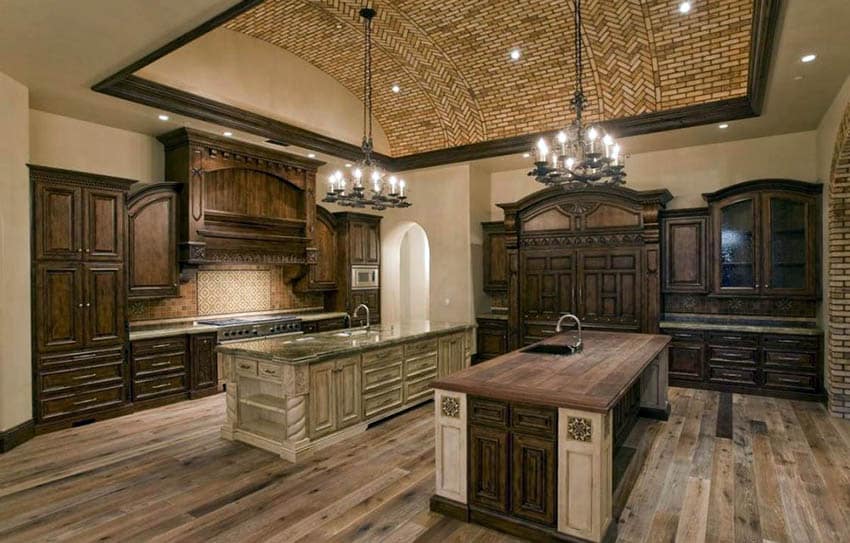
As with any cabinet color, the first thing that you have to think about when choosing a paint color to complement brown cabinets is the visual attribute that you want to stand out in the space – whether it may be contrast or harmony. If you want brown cabinets to blend in or disappear in space, opt for a paint color that is one to two shades lighter than your cabinets. Whereas, if you want to complement the wood and make your brown cabinets the focal point of the space, find a paint color that comes from an entirely different family or palette but still has a complementary tone, such as light neutrals or cool hues.
In general, a kitchen is dominated by brown or wooden cabinets with earth tones, neutrals, and cool hues. Here is a look at the best paint colors to complement brown cabinets, classified according to the effect you want to achieve:
Harmonizing paint colors for brown cabinets
Shades of brown – The only way to blend brown cabinets into a space is to choose a paint color that belongs to the same color family. Think of light tans, mocha, taupe, sand, khaki, and tortilla. Ideally, if your cabinets have a mid to dark brown, choose a paint color that is one to two shades lighter in order to create the perfect balance and layering of colors. Although the goal is to blend and harmonize, you still do not want to camouflage your brown cabinets entirely into the space and mask their beauty under the same exact shade of wall color. Alternatively, you can also choose a shade of paint that closely matches one of the wood grains in your cabinetry.
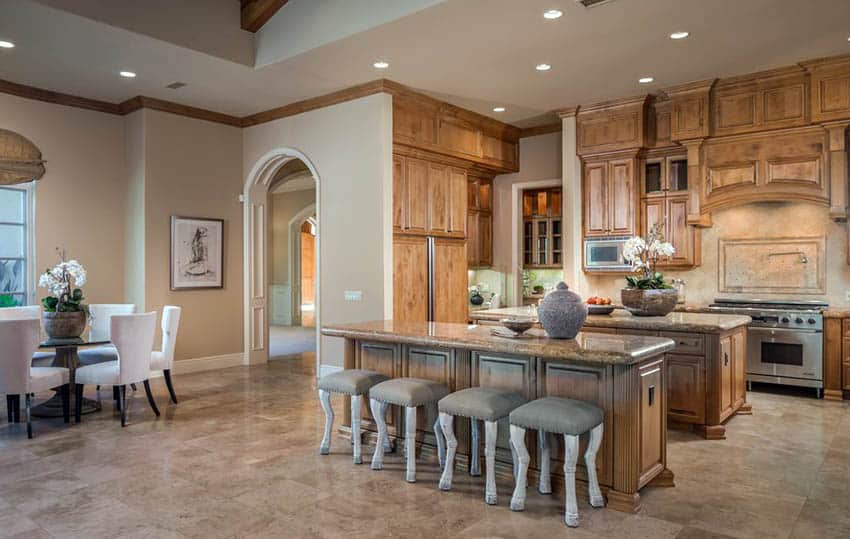
Opt for muted brown paint colors that make a statement, such as taupe and soft mocha, because they have just the right tonality, which can match brown wooden cabinets, whether they may have a light or dark finish. Avoid dark brown paint colors because they can make your room feel smaller, and they can also lessen the appeal of your wood cabinetry.
Try :
- Hush by Benjamin Moore (taupe)
- Consentino Chardonnay by Benjamin Moore (light mocha)
- Blonde by Sherwin Williams (tan)
- Nutshell by Martha Stewart
- China Doll by Sherwin Williams
- Universal Khaki by Sherwin Williams (dark taupe)
Contrasting paint colors for brown cabinets
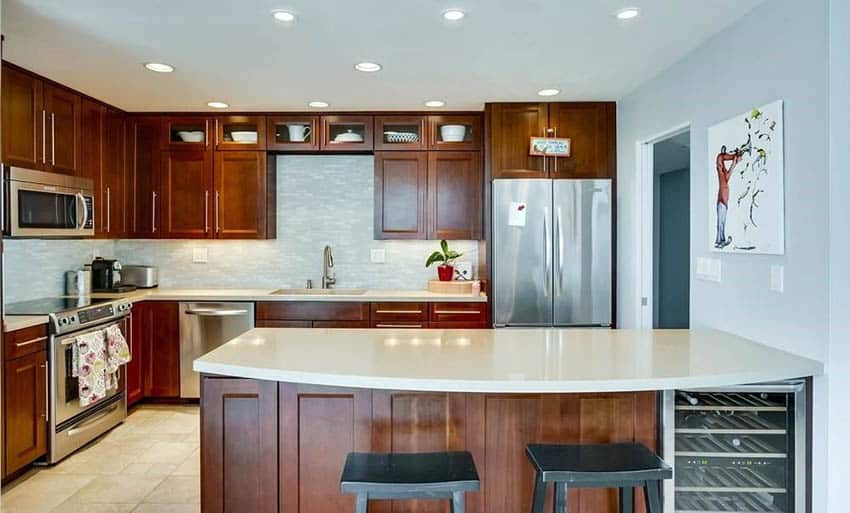
Explore paints in shades of light blue, medium blue, muted blue, soft grays, turquoise, aquamarine, and teal to match with brown cabinets. While for green, try light shades such as mint and sage and muted tones such as olive, moss green, and fern green. Cool hues can help make your space feel calmer and more refreshing. Also, try to introduce some type of neutral with cool undertones. When paired together, cool hues and brown cabinets appear cleaner and brighter.
Light neutrals – Another way to create contrast with brown cabinets is to pair them with light neutral paints such as white, ivory, or light gray. Light neutrals work, especially if your cabinets are generally dark, as they help provide contrast. Also, a light-colored wall will allow your brown cabinets to stand out in the space, so if you want your cabinetry to be the focal point, then this is the way to go.
The best thing about pairing light neutral walls with brown cabinets is that it allows you to add any type of accent color to the space. Neutral colors are meant to compliment just about anything, so mixing and matching your countertops, flooring, appliances, and accessories are the least of your worries. Also, when placed against a white or soft gray colored wall, brown wooden cabinets look brighter. In addition, light neutral paints can likewise help the space appear more clean.
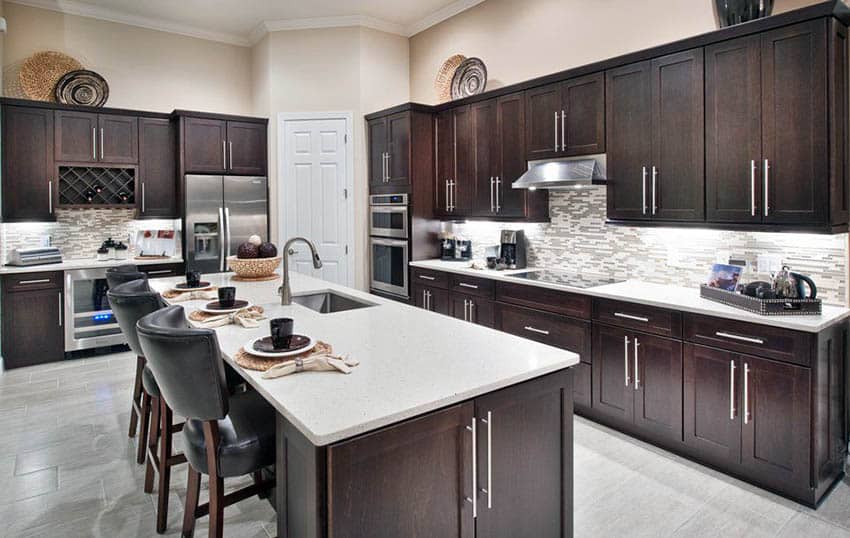
Try :
- Ancient Marble by Sherwin Williams (greige)
- Gray Owl by Benjamin Moore (soft gray)
- Upward by Sherwin Williams (gray with bluish undertones)
- Oat Straw by Behr (white)
- Ocean Pearl by Behr (light gray)
- Rice Grain by Sherwin Williams (pinkish undertones)
- Softened Green by Sherwin Williams (gray with green undertones)
Best Paint Color with Cherry Cabinets
Cherry cabinets are a true stand-out feature in a culinary space design. People love its rich, deep color and the natural warmth that it contributes to a space. And since cherry cabinets boast of distinctive, genuine aesthetics, the last thing that you would want to do is to hide that beauty against a poorly chosen color scheme.
Fortunately, the natural, rich, deep color of cherry cabinets makes way for a lot of possibilities in terms of design. Thanks to its red undertones, formulating the right color scheme to go with it can go anywhere from enhancing its luxurious look to toning down its richness. There are several wall paint colors that can be explored to match dark cherry-colored cabinets.
You can go with subdued neutrals like gray that help enhance its warmth, crisp white walls that help tone its richness, earth colors that help its warm undertones stand out, deep shades that make it ultra-rich, or mellow pastels that balance it out. From this, we can derive that the paint color you choose will ultimately depend on the aesthetic value that you want to emphasize and, of course, your personal taste and style.
Choosing the right paint color to go with your cherry cabinets can help you produce an overall look that is not only stunning but also cohesively tied together. Here, we narrow down some of our best paint colors to match cherry kitchen cabinets :
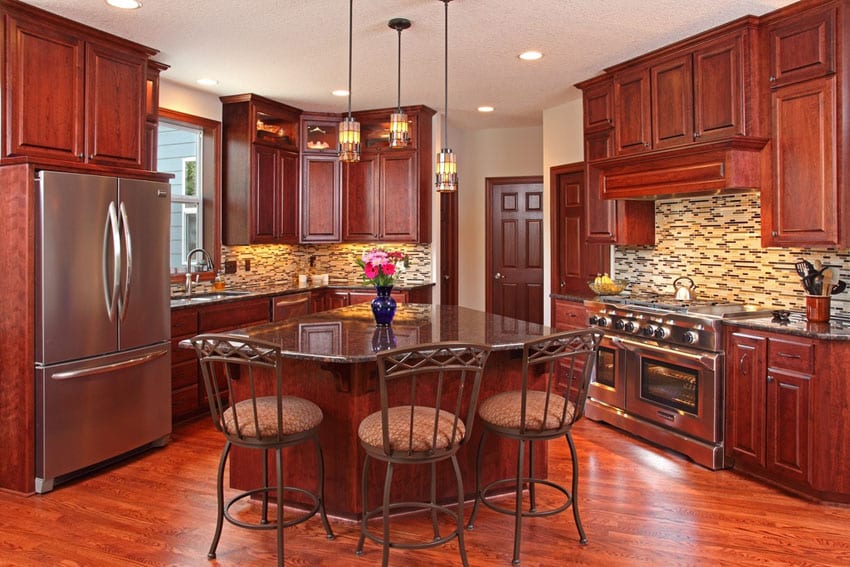
Earth tones are popular wall colors for cherry wood cabinets because they do not compete with the richness of its natural red color, rather, they blend well with each other. A beautiful earth-tone paint can serve as a backdrop for the dark reddish color of cherry wood. This type of paint color can go well with anything, and when paired together, they create a stunning neutral color palette that provides a wide range of possibilities in terms of mixing and matching accessories.
When choosing the right earth-tone paint to go with your cherry wood cabinet, it is best to opt for shades that belong from the mid to the lighter end of the brown spectrum. Light and medium browns, such as sand, tan, and light mocha, are incredibly well-suited for cherry wood cabinets because they can make the wood look brighter and cleaner. Alternatively, you can also try cream-colored paints with brown undertones. Avoid darker shades of brown because they tend to camouflage cherry wood cabinets and have the tendency to make the space too heavy on the eyes.
Wall paints in shades of brown paired with cherry wood cabinets also present the perfect opportunity to go with a monochromatic color scheme. Together, these colors complement the inherent color of wood and its natural coziness, making the space more inviting and homelike. To create a visually pleasing monochromatic color scheme, make sure to balance out the different shades to create some dimension. This can be achieved by varying the colors through textures, materials, and finishes.
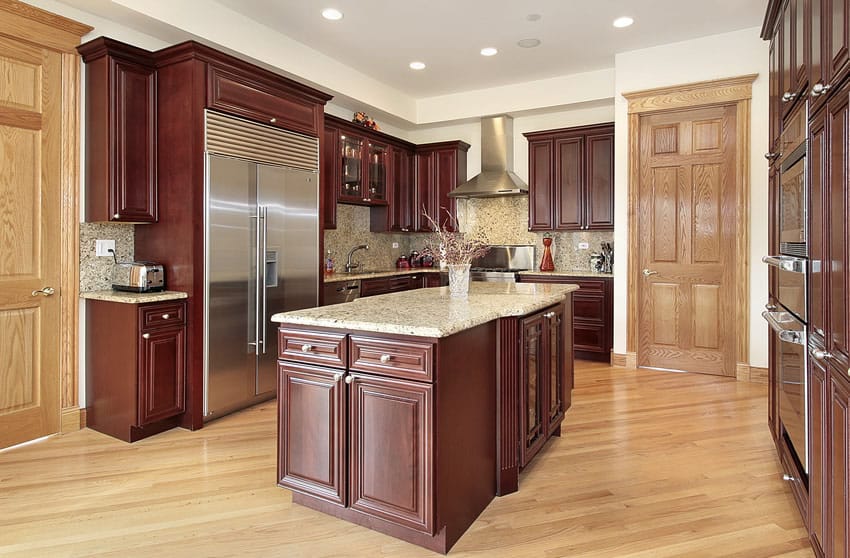
The main effect of the combination of white walls and cherry cabinets is that it makes the wood appear brighter and cleaner. Also, white walls are perfect for creating a stark contrast between dark cherry cabinets. It does not compete with the inherent richness of the wood but instead allows it to stand out in the space. If you have a small cooking space, white walls can help make the space appear bigger, more spacious, open, and airy. Because the color white reflects light well, it can also make the space look more illuminated. It can instantly brighten the space, and lessen the “heaviness” that comes with the ultra-rich color of cherry wood. Aside from that, white walls have a timeless look that will surely never go out of style and present a wide range of design possibilities for your countertops, backsplash, and flooring material.
The color white comes in different tones, which one can explore. Some have tinges of peach, blue, gray, yellow, or brown. It is available in cool tones such as ultra whites, bright whites, pure whites, bluish-whitish, and grayish whites, and it also comes in warm tones such as cream, beiges, ivory, and off-white. Both cool and warm shades of white can be paired with cherry wood cabinets to create a well-balanced color scheme. Bright, crisp white walls can be paired with dark cherry cabinets if you are aiming to create a fusion of classic and contemporary styles. However, if you are not a fan of the striking color of bright white walls, opt for other shades with warmer undertones. Beige, cream, ivory, and off-white are perfect wall paint colors for traditional-inspired kitchen settings with dark cherry cabinetry.
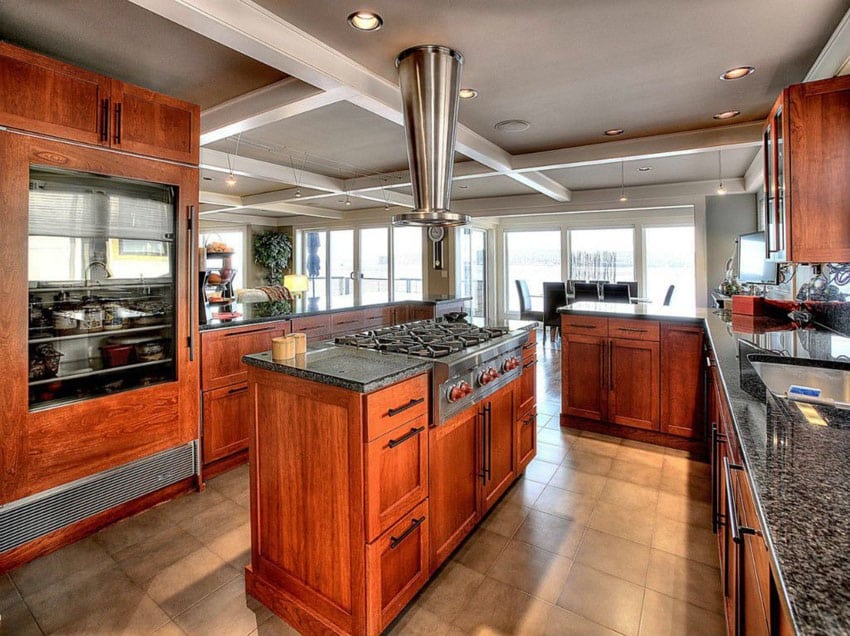
Although both light and dark shades of gray can be used as wall paint colors for cherry cabinets, those that belong to the lighter or cooler end of the spectrum are your best bet – think of cloud gray, fossil gray, soft gray, and taupe. In general, it is best to avoid shades of gray that are too dark or lean toward black, such as charcoal, shadow gray, and iron gray, since it can make the space appear too heavy on the eyes and make it feel too cramped. When paired together, cool shades of gray and dark cherry cabinets create a dramatic effect. Gray walls are very subdued, can lend a quiet strength to spaces, and are not overwhelming. They won’t steal away the spotlight from the beauty of rich, cherry wood cabinets.
Warm yellows – If you want to add a bit of color to your rich red cherry cabinets, try yellow paint for your walls. A warm, sunny shade of yellow can help add warmth to cherry cabinets, making your cooking space feel more inviting and welcoming. Warm yellow walls are also a great way to introduce a cheery ambiance to the space without being too intense. When choosing the best shade of yellow paint with cherry-colored cabinets, opt for light honey, mellow butter shades, and golden yellow.

Different shades of green work well with cherry-colored cabinets, all of which can be explored, depending on the effect you want to achieve for your culinary space. To create a subtle effect of contrast and introduce a hint of color, try mellow shades like tea green, mint green, and celadon green. Lighter shades of green allow the beauty of cherry cabinets to stand out. Muted shades of green like moss green, sage, and olive green can help tone down the richness of cherry cabinets, while deep and dark shades of green like hunter green and forest green can help enhance drama in a space. Darker shades of green are also more commonly used for traditional kitchen settings.

There are many pastel shades of paint to choose from. Some have cool undertones, while others have warm undertones in them. Cool pastel colors include light blue, light green, and soft grays, while warm pastel colors include mellow yellows and peach. These two opposite ends of the spectrum work differently when paired with cherry wood cabinets. Pastels with cool undertones can help uplift the natural grains of cherry wood, make it appear brighter, and make its color pop out more. Whereas pastels with warm undertones can make cherry wood appear warmer and more inviting.
Just like any light color, pastel colors help create an illusion of a much bigger space. When paired with dark cherry wood cabinets, they create a more well-balanced look. As mentioned, pastel-colored walls can make the richness of the wood also pop out more. Thus, they are highly suited if you want to make your cherry cabinetry the main focal point of your kitchen.
If pastels do not fit your taste, you can create a more muted and subdued shade of color by toning it down with a bit of white or cool gray. Orange, for example, can be mixed with white to create a peach hue, or green can be mellowed with a bit of gray to create sage. This provides more options for decorating kitchens with cherry wood cabinets. Although light colors, in general, work best with cherry-colored cabinets, there are still some shades that can look a bit off as part of their color scheme. Lavender, pink, and light blues are colors that belong to the same family, so they do not work well as much as light oranges, yellows, and greens.
Wall paint colors to avoid for cherry cabinets:
Reds. Although they belong to the same color group, there is a tendency for cherry cabinets and red walls to compete for attention. Since red is the primary undertone of cherry cabinets, matching it with a red wall may overwhelm the space. Also, avoid colors that are too vivid and bright, as they can overpower your cabinetry color. Pink also does not go well with cherry cabinetry.
Black and dark grays – Neutral colors that you have to avoid for cherry cabinets are black and dark grays. Black is too dark and might clash with the reddish undertones of cherry cabinets. Dark grays also do not complement cherry cabinets well and may be too heavy for the eyes. The last thing you want is a wall color that will compete with the real beauty of your wooden cabinetry.
For more related ideas, take a look at our gallery of dining room paint colors to put together a cohesive design you’ll love.


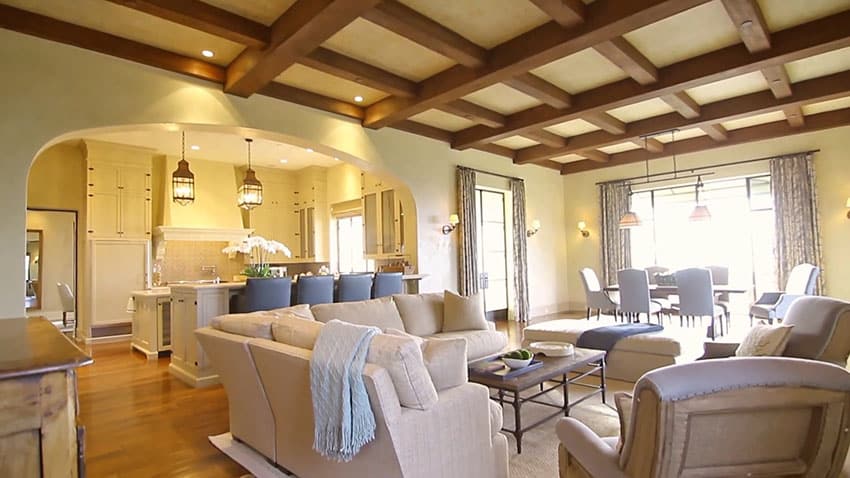
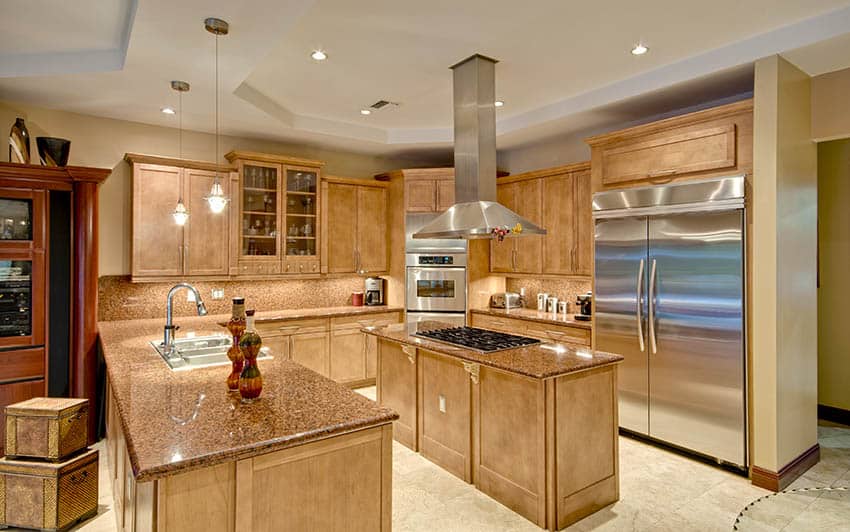
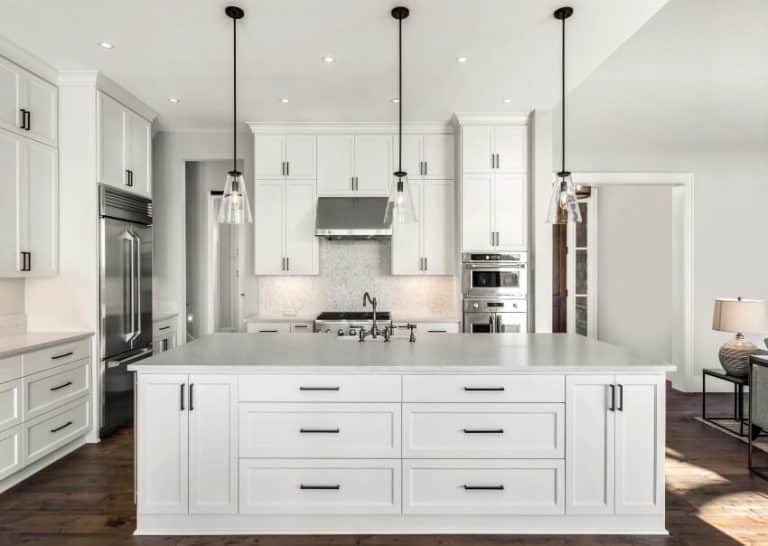


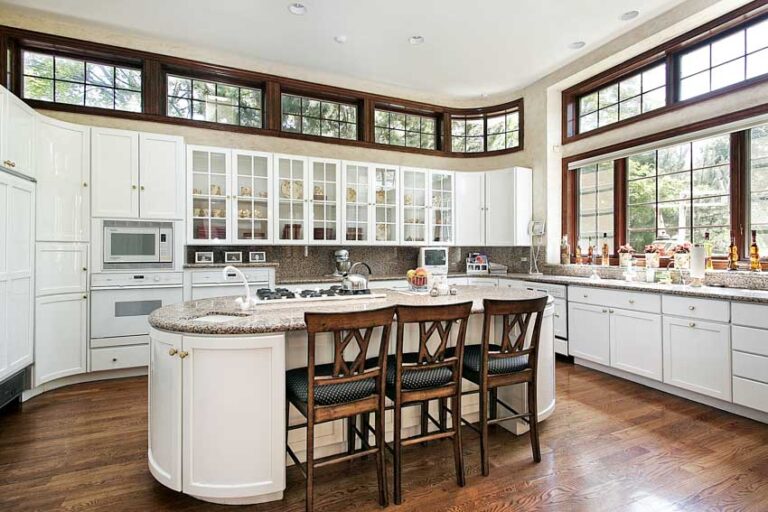
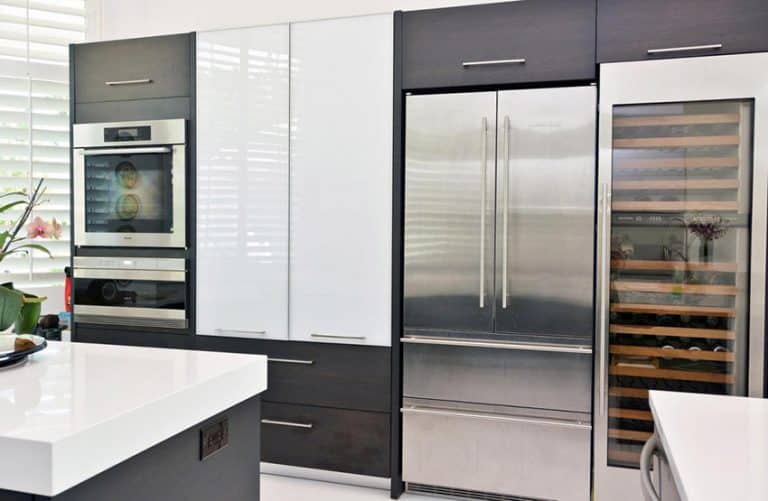
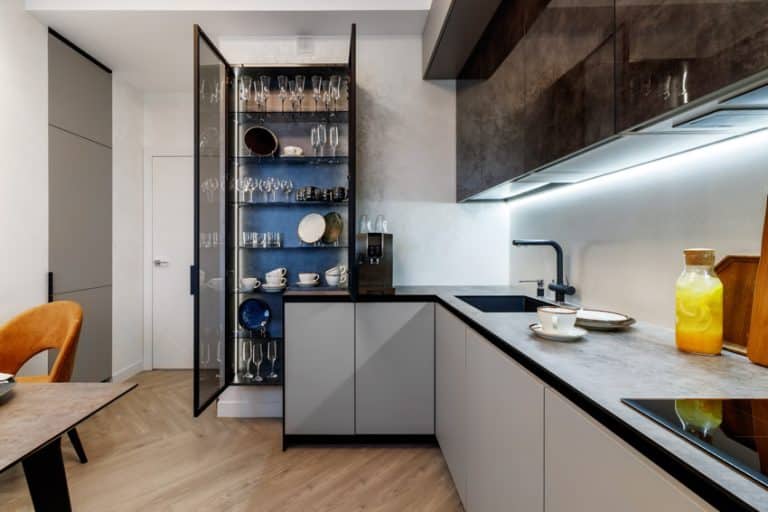
I wanted to see if you could help me with one of your photos. I have absolutely fallen in love with the kitchen bar stools with the leather backs and wanted to see if you could tell me the name of them.They are the cream colored bar stools with the round decorative holes in the back, pictured in your article about dark colored kitchen cabinets
I took a look and was unable to find those exact bar stools. They look like a bar stool that used to be sold at Williams Sonoma but have been discontinued. Good luck
Please tell me the manufacturer of the pendants in the 10th picture on the website. The kitchen starts the section titled “10 Best Pant Colors for Kitchen Walls”. They are very unique!
That is an interesting pendant light. Unfortunately, we don’t have the model or manufacturer for that fixture on file. Thanks for your question.